A 452% increase in customers between March and May. Turning away new customers and hiring an extra 400 people. Securing £33million in new investment. Sales growth between 40-55%, above the projected 22-27%, and supplying over 70,000 UK households during lockdown.
Unfortunately, not many sectors and businesses can boast such figures during the global pandemic. But if you’re part of the three-strong oligopoly of; Mindful Chef, Gousto and Hello Fresh, that dominates the hugely popular recipe box sector, worldwide lockdown has seen their businesses go from strength to strength.

But, like with every industry and brand, there are countless opportunities to improve these figures further with effective and strategic content creation that is underpinned by a carefully devised content strategy. While often deprioritised, the role that effective content creation can have on ecommerce has been evidenced on multiple occasions, including in this study on Search Engine Land.
In this article, I’ll explore the content opportunities that exist in even the most booming of sectors and how to avoid one of my biggest bugbears, creating content for content’s sake. Even if you’re not in this sector, or the food and drink industry more generally, I’ve included a number of points to consider and how to apply them to the sector that you’re working in.
I should mention that this is not a critique of the biggest players in this sector, who have achieved huge success and, instead, looking to highlight that every sector has opportunities with strategic content creation. The examples shown are just a snapshot in time and have been accumulated over a large date range. If you’re short on time, here’s some quick links to the different sections.
- Brand Positioning
- Understanding The Competitor & Search Landscape
- Understanding Your Audiences & Their Motivations
- Understanding Your Keyword Priorities & Where Prospects Are In The Buyer Cycle
- Who Are They Targeting Currently?
- Maximising Your Content Marketing Efforts
- Are Recipe Box Companies Here To Stay?
TL;DR
There’s so much to consider when devising your brand’s content strategy that extends way beyond chasing search volumes.
- Aligning your content with your brand positioning and purpose, your key points of difference and business growth areas will enable you to connect more effectively with your audience.
- Know where your competitors are concentrating their content creation and take the learnings from what’s working, as well as where the gaps are. These are the brands that you’re competing with in the search results, not just those you’d consider to be your direct competition.
- Use search intelligence tools to see where the market is aligned, the level of indirect competition, the degree of keyword / topical crossover and the relative visibility of each.
- Know the composition of the search results pages, which features are prominent (recipe cards, video carousels, map packs etc) and build a strategy to occupy those points that matter – beyond traditional channel boundaries.
- Embrace structured data and mark up your content, to facilitate it being displayed in innovative ways across different SERP features and even voice search.
- Leverage the full value of personas. Know what motivates your audience and what they are trying to achieve. Match your content to these to establish its real purpose.
- Get familiar with the search context behind your personas and understand when they’re searching and consider what is more valuable to them at that moment.
- Ask yourself whether you are trying to satisfy existing demand or helping to generate new demand. Once booming markets reach saturation, additional growth will come from acquiring those not directly looking for your service, which requires you to tailor your content (and its marketing) accordingly.
- Don’t get stuck aiming your content at what you can see now, aim for what’s valuable to your audience, both now and in the future.
- Understand where prospects are in the buyer journey and prioritise the content that is closest to conversion / of most value to your business.
- Look for the areas of dissonance and fractured intent. Where is there clearly intent, but no content (both organically and paid) rising to meet that and giving the user what they want?
- Use paid search to test targets, topics and new approaches before investing in organic search for the long(er) term, to ensure your organic targets are worth investing time and resources in.
Ultimately, content marketing needs to stem from beyond just producing content because you feel you need to. The strategies that will win here are well thought out ones that understand their audience (and the shifting behaviours / needs) and underpinned by a technically sound website.
1. Brand Positioning
Before you dive straight in at the content ideation stage, it’s important to consider your brand positioning relative to other competitors in the market. Looking specifically at the Recipe Box sector, the three leading players in the market have very distinct messaging;
| Gousto | Mindful Chef | Hello Fresh |
| ‘Give It Some Gousto’ ‘Unbox Possibility’ ‘Dollop of Adventure’ ‘Reinventing Meal Times’ ‘Join the Table’ | ‘Make Healthy Eating Easy’ ‘Healthy Recipe Box Company’ ‘UK’s Favourite Recipe Box’ ‘Cook Healthy, Low Carb Meals in Under 30 Minutes’ | ‘Dinner Is Solved’ ‘Saving You Time, Stress and Money’ ‘Enjoy Delicious Moments’ |
Gousto’s is very much focused on improving the variety of your home cooking, trying something new, ‘a dollop of adventure’ and ‘reinventing meal times’. The latter is in keeping with ‘The Creator’ brand archetype developed by Carl Jung, with Gousto claiming to reinvent how we do meal times (and similar to how Harry’s were able to steal market share from Gillette with their ‘Welcomed Prophet’ positioning).
HelloFresh focus more on the convenience angle, with messaging such as ‘Dinner Is Solved’ and ‘Saving You Time, Stress and Money’.
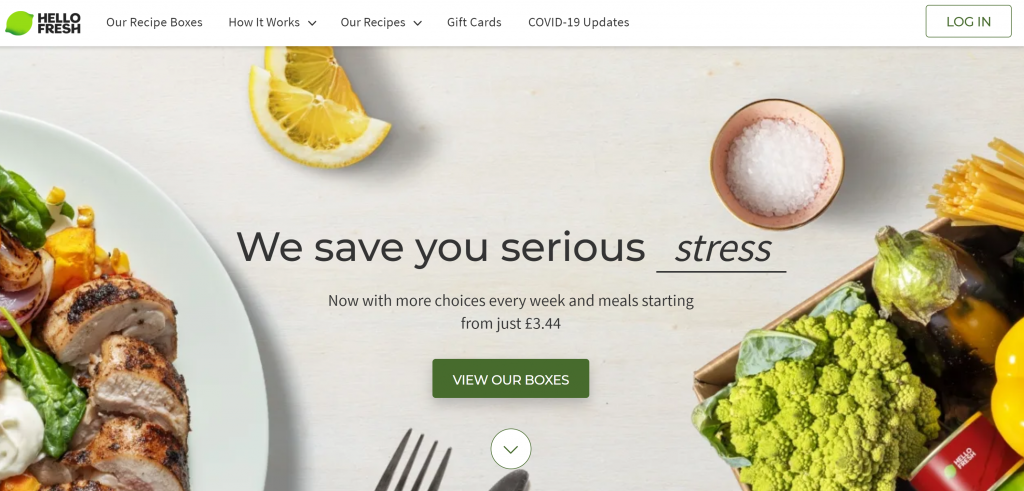
Conversely, Mindful Chef’s mission is to ‘Make Healthy Eating Easy’, with the emphasis on delicious, low carb meals that you can make in under 30 minutes.
This competitor research is essential so that you establish their attempted points of difference (the extra value that they’re offering above and beyond what the rivals are) and understanding what the points of parity are within the market (the minimum expectations of the buyer e.g. good quality ingredients) which wouldn’t be enough to get you to purchase on its own. Over time, you can neutralise competitors’ point of difference and demote them to a point of parity with careful messaging and, then, successfully differentiate yourselves in other ways.
Application
It’s worth conducting regular questionnaires with your customers and prospects, to ascertain any differences between actual and desired positioning, to see if their brand perception marries up with your intended positioning.
Establishing Your Brand Purpose
One of my favourite ways to establish your brand purpose is to use the model developed by Wolff Olins in what they’ve coined ‘The Brand Butterfly’.

This attempts to bring together what the world needs (e.g. the consumers’ main motivations), with what you’re good at (e.g. what’s special about you?). This is effectively the strengths of your SWOT analysis working in conjunction with the external opportunities and can help to unlock a brand purpose that resonates with your audience.
Considering Your Business Growth Areas
Your content efforts should be prioritised towards your key revenue driving products / services.
Application
Take a look at your current revenue mix (and the breakdown across products / services) and what your desired revenue mix looks like. Also consider any market changes that you’re foreseeing that will impact your industry and which areas of your business are likely to grow in importance going forwards. You can also map these using a slight adaptation of the BCG Matrix by reviewing your products / services against a consideration of current revenue and growth potential.
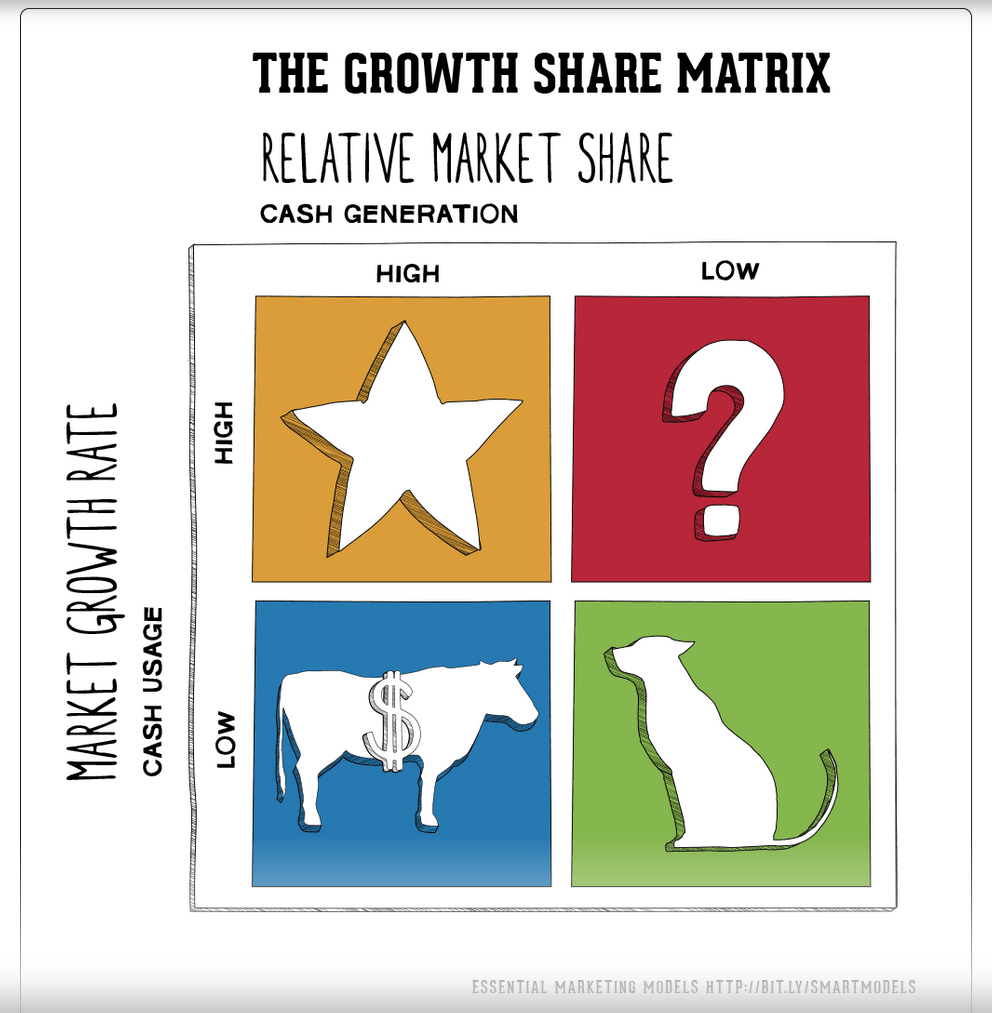
2. Understanding The Competitor & Search Landscape
Considering Your Indirect Competitors
In many industries, the focus is on your identified competitors. So, in this case, Gousto would only be interested in HelloFresh and Mindful Chef. Not only are there high numbers of challenger brands entering this market, there’s also ‘search / content competitors’ that you need to consider too. These have a high level of keyword crossover with the Food Subscription companies but don’t directly offer the same service. Many include online food magazines (such as Delicious Magazine and BBC Good Food shown below), with the former having a huge breadth of keywords that they rank for relative to the Recipe Box companies, and a high level of organic search traffic from it. Other examples include the websites of highly popular celebrity chefs e.g. Jamie Oliver, Gordon Ramsey etc and even supermarket chains.
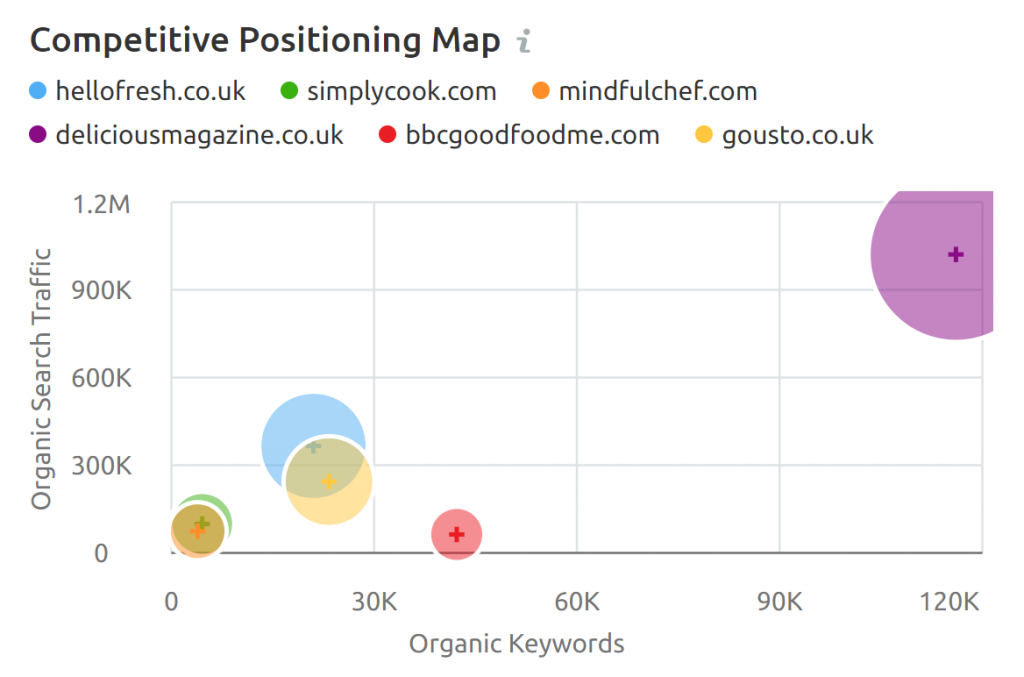
This is further highlighted in Sistrix’s Competitor Leaderboard for this sector (see below), which shows the relative visibility across the direct and indirect competitors, with Gousto currently occupying 18th place in the leaderboard, HelloFresh in 35th place and Mindful Chef in 521st place (which is to be expected due to the size of the competitors in this space and the scale of some of these competing sites).
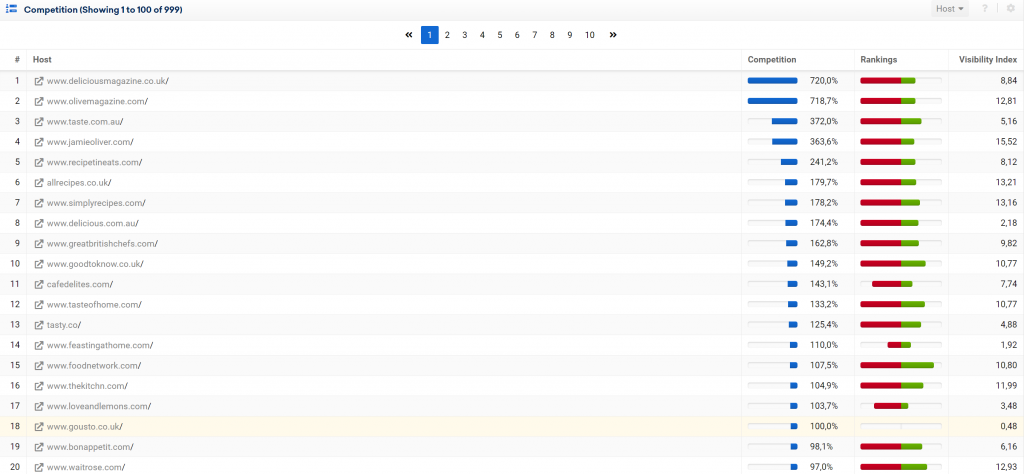
Application
Many brands will conduct direct competitor research but it’s worth considering who else you’re indirectly competing with and seeing what’s working well for them (and, therefore, where the opportunities are in a broader category sense).
Understanding The SERP Features
SERP features have continued to evolve and take up more ‘real estate’ within the search results. One such feature that any brand that operates within the food and drink sector needs to be aware of is recipe mark up. With the addition of more new features and ways of displaying the search results, beyond the normal ‘10 blue links’, this greatly impacts the click-through rate for both the paid and organic listings. In a recent Sistrix study, they found that the average click-through rate for the first result is approximately 25.5% for a query that triggers recipe cards within the results, which is slightly lower than the percentage that is normally associated with that much sought after position (ads aside).
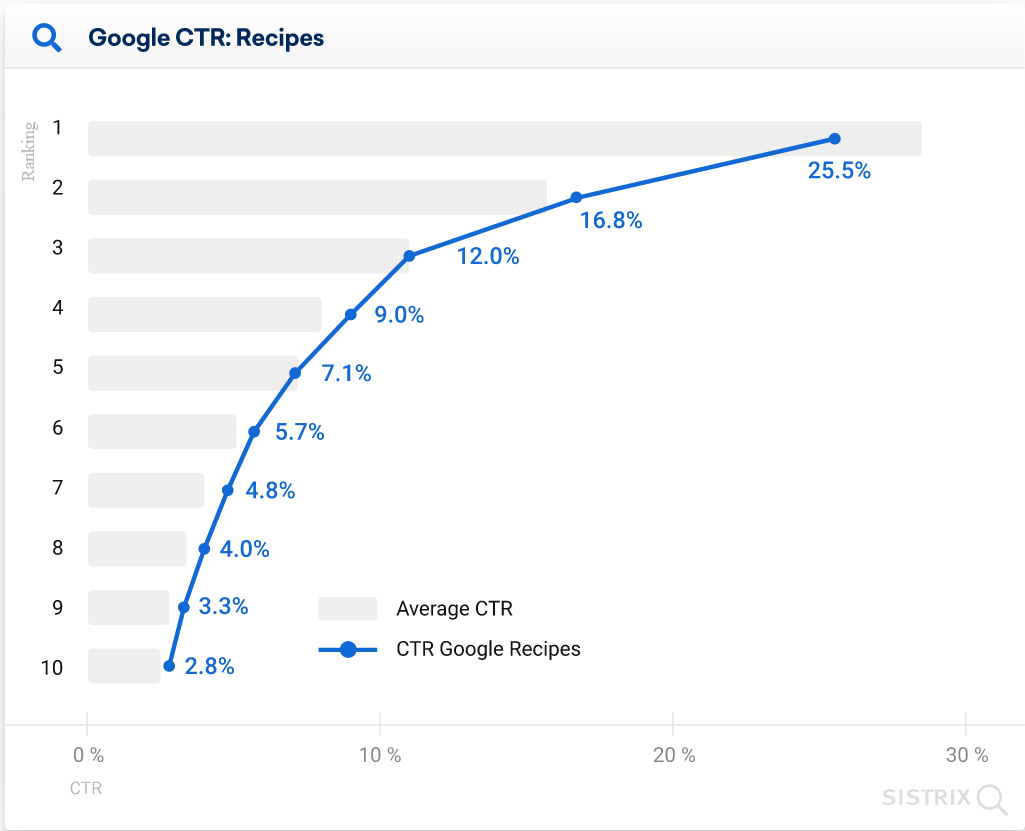
Each of the leading players in this space are using recipe mark up. However, to aid conversion, some recipes are housed in a pop-up modal, as opposed to a standalone page. An example being this Mindful Chef recipe selection page which means that they can’t use recipe mark up on the recipes listed on this page. Conversely, Gousto have standalone recipe pages with the correct mark up, as you can see from this Rich Results test. Even with correct recipe mark up in place, there are ways that these results can be improved. One example being the lack of reviews for these HelloFresh recipes.
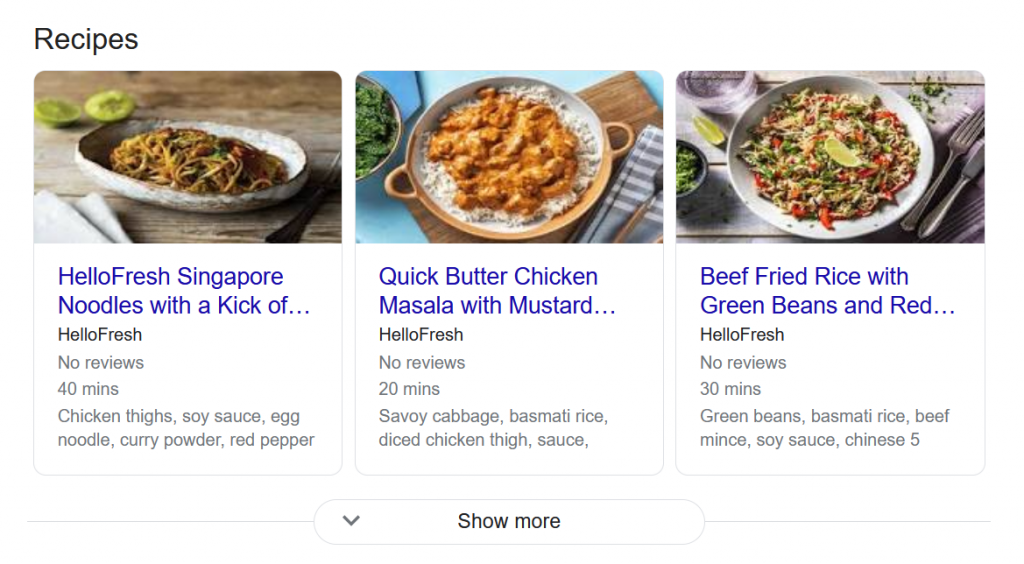
3. Understanding Your Audiences & Their Motivations
Persona work, while often overlooked, is a key initial step in any successful marketing strategy and, therefore, subsequent campaigns. Understanding consumer motivations, interests and what drives their behaviours is essential for any tactical delivery and, in particular, content creation. In many instances, it will unlock new opportunities with your audience that you hadn’t initially considered.
So, who are the main personas for this new breed of cook-at-home enthusiasts? For me, they fit nicely into 5 distinct groups of buyers, with each detailed below. For each persona type, I’ve documented their main drivers, how they are likely to search and how you can target them from both a paid and organic search perspective.
A) Persona A – Busy working parents (driven by convenience)
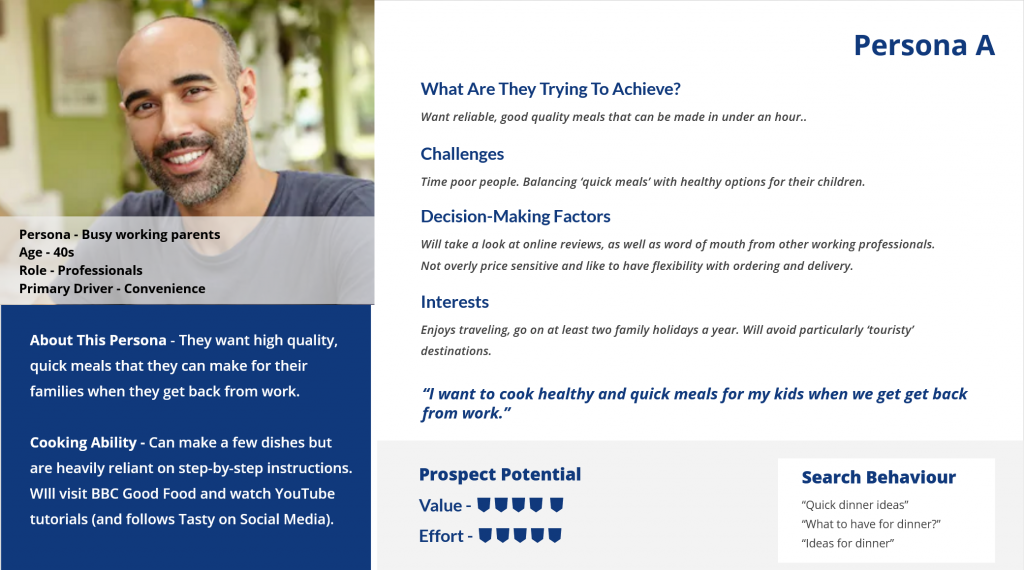
This demographic wants high quality, quick meals that they can make for their families when they get back from work. They aren’t overly price sensitive, with the emphasis firmly on convenience, as well as healthy and nutritious meals.
“I want to cook healthy and quick meals for my kids when we get back from work.”
Search Behaviour;
This demographic will seek inspiration online for quick, family meal ideas. They could perform searches such as the following;
- Ideas for Dinner Healthy (40,500 searches per month*)
- Quick Dinner Ideas (9,900)
- Ideas for Dinner Chicken (8,100)
- Ideas for Dinner Vegan (5,400)
- Ideas for Dinner (4,000)
- Ideas for Dinner Simple (2,900)
*Approximated search volume data from Keyword Keg
While the quantity of Voice Searches haven’t reached the lofty heights that were predicted by 2020 (50% of all searches), a number of the queries above do appear to be screenless searches (e.g ‘ideas for dinner chicken). With more connected devices around the home, particularly in kitchens and the messy nature of cooking, this is one sector that has a very relevant use for voice search. From my own tests, it’s BBC Goodfood that are appearing for the majority of the above searches on my Amazon Alexa (shown below).

Matching Content For This Persona (‘Ideas for Dinner Healthy’)
One very important consideration, before crafting your content, is the context in which they’re searching, as it will influence the content that you produce. It’s likely that those that are searching for ‘Quick Dinner Ideas’ are looking for inspiration for that evening. Whereas, those asking ‘ideas for dinner vegan’ might be meal prepping for the week ahead and are in the process of making a shopping list. Therefore, the content should have an appreciation of their immediate needs and how you can craft messaging that resonates with them.
So, now that we know how these individuals may search, a rough approximation of the scale of these monthly searches and a consideration of the context in which they’re searching, how do we produce content that is valuable to this audience?
When looking at the current search engine results page (SERP), it’s clear that it’s rewarding ‘listicle’ content (recipe inspiration in a list format), with all of the top performing pages providing a large selection of healthy dinner ideas. Examples of this are also clear in the page title of competing pages with; Delish (80+ recipes), Good House Keeping (80+ ideas), Waitrose (100+ ideas) and Country Living (75 recipes).
Opportunity for Recipe Box Subscription Companies
The likes of Gousto, especially with their focus on variety, would be able to create an exhaustive list of healthy recipe ideas that are all available within their subscription boxes. This would need to be at least 50 recipes to give users the variety that is offered by competing pages and to increase the chances of finding options that meet different dietary needs and food preferences. .In the aforementioned tests, it was BBC Goodfood that were dominating the voice search results. Even when asking to skip a particular recipe, it was returning another recipe from BBC Goodfood, which will have been helped by the fact that they’re using ItemList structured data which clearly communicates the order of the recipes on the page.
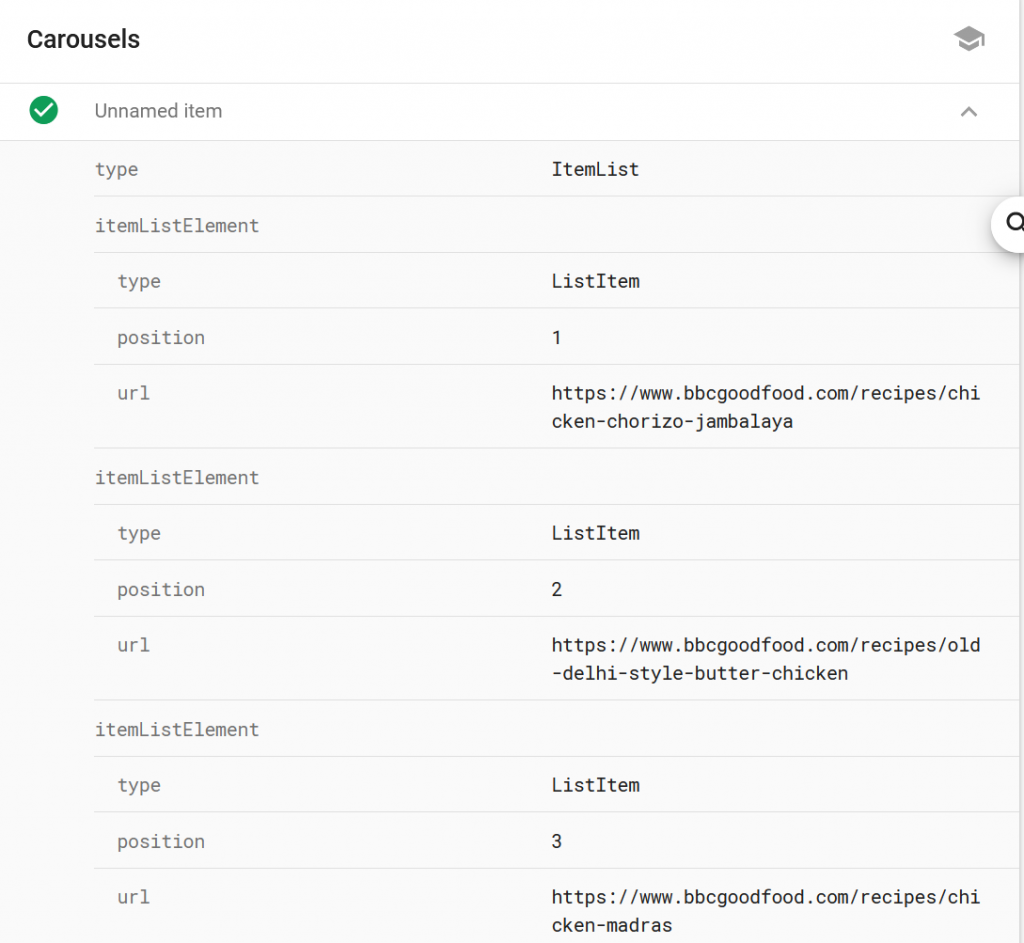
More information about how you can mark up recipes, including more on ItemList structured data can be found here.
Application;
Helping Google (and other search engines) to understand more about your content enables them to display it in more innovative ways, with our search results pages continuing to evolve from the ‘10 blue links’ that seem like a distant memory. You can find other ways to mark up your content for both voice assistants and search more generally here, as well as the fantastic schema.org library.
Returning to the search results themselves, it’s interesting to see that none of the 3 big players in this space are visible within the top 100 results for the term ‘Ideas for Dinner Healthy’ and closely related queries. However, HelloFresh are bidding on the term from a paid perspective, with the landing page in question being the Homepage and not a custom landing page specifically for users looking for this high volume, high intent search (which will have an impact on the Quality Score and the perceived relevance of this particular ad to in-market users).
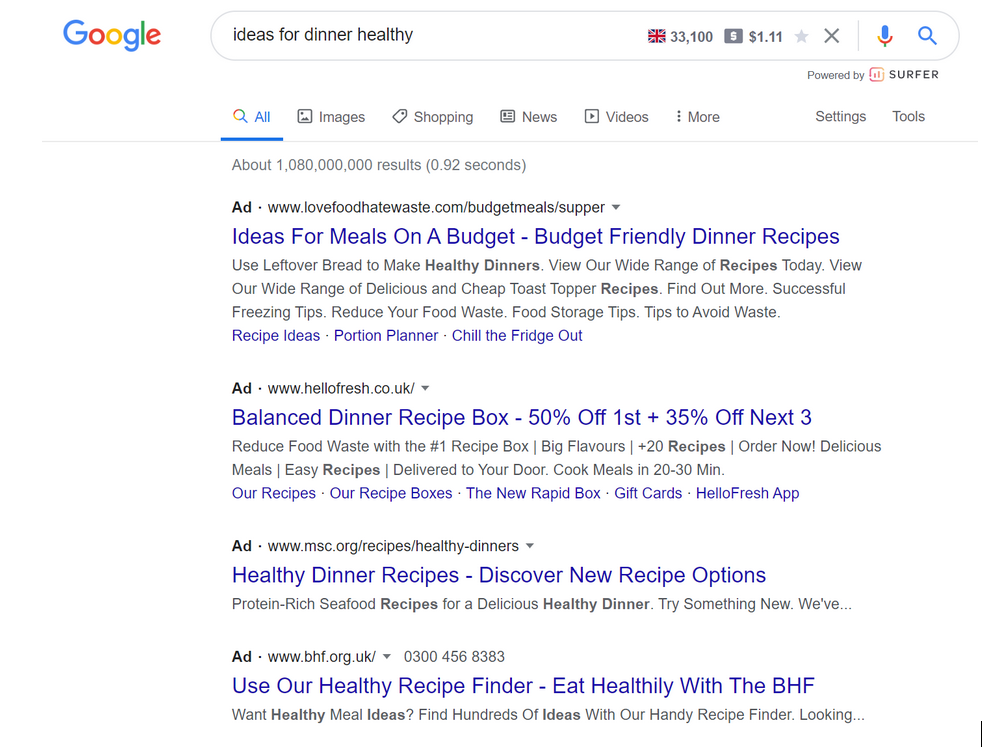
Paid Opportunities
Beyond a stronger landing page experience identified above, there are a plethora of other paid opportunities for the leading brands in this space (as well as those savvy challenger brands, of which there are now hundreds, such as the below).
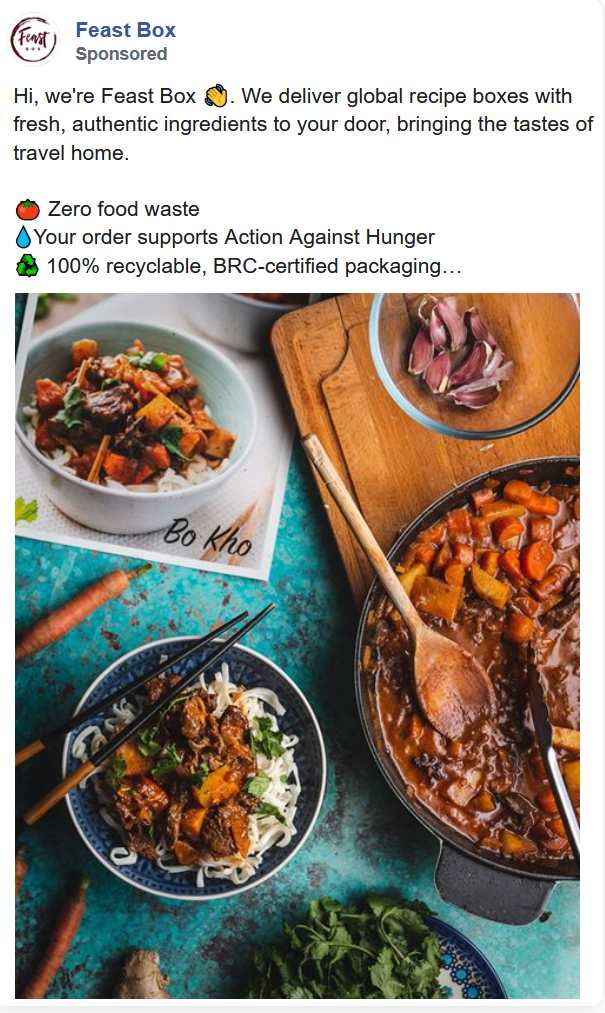
One such content opportunity is around the ‘15 minute meals’ that, due to the highly successful TV and book series, is strongly associated with celebrity chef, Jamie Oliver. According to keyword data from Keyword Keg, there are in the region of 1,900 searches per month for ‘15 minute meals Jamie’ and 1,000 for ‘15 minute meals’. The individuals performing such searches are very much driven by convenience and speed but, the fact that they’re searching for a chef that is so heavily associated with healthy eating, still want to cook nutritious meals for themselves / their families.
As you’d expect, the ‘15 minute meals Jamie’ query triggers a knowledge panel in the search result, with the jamieoliver.com domain ranking in the top 3 positions for this term.

Similarly, for the term ‘15 minute meals’, this largely owned by the jamieoliver.com domain, with BBC Good Food also crafting a strong category page to target some of this search interest.
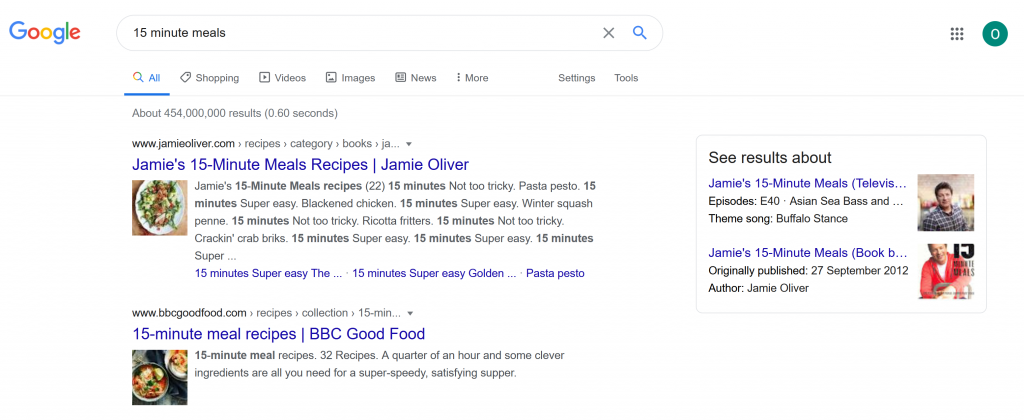
So, with this strong association and the ‘navigational intent’ to visit the Jamie Oliver property, as well as ‘powerhouse’ domains (such as the BBC Good Food domain) occupying this space, it does make it a particularly difficult target for organic campaigns
However, as you may have noticed from the two screenshots above, there is no paid competition on these terms currently. Having monitored this SERP over a short period, I have, on occasions, seen the first ad unit appearing at the bottom of page 2 which could be due to a low perceived quality score in Google Ads, low bids or Google deeming the result to not be relevant enough to the search.
Whether this has been tested previously, and not yielded the desired return on ad spend, or serves as an untapped opportunity remains to be seen. Others may have deemed this to be a poor target, such is this association with the Jamie Oliver brand and distance from conversion but, for me, the only users that would click this ad (excluding accidental clicks) would be those that could be open to alternatives for quick meal inspiration.
Application
This leads to a key but often overlooked point that is worth asking yourself.
Are you fulfilling existing demand or creating new demand?
In the above example, you would be creating new demand from a group of buyers that are used to searching for this type of inspiration but with a message heavily centred on convenience, as well as the quick recipes that they are seeking. They aren’t looking specifically for a food subscription service, as they haven’t recognised the need for that service, but could be nurtured with powerful messaging.
Example PPC Ad
Let’s have a look at what a paid ad could look like for individuals trying to capture a slice of this traffic.

The key elements of the ad above, that I believe would work well, are the following;
- Mention of 15 mins in the ad headline to improve the CTR and overall quality score
- Communication of quick and healthy driver
- Highlighting the variety and range of meals available (something that people looking for Jamie Oliver’s 15 minutes are likely to crave)
- Review stars to highlight the positive feedback and to act as a trust signal
- ‘Take the stress out of meal planning’ is a powerful CTA that will resonate with a large number of prospects
- Reduce the perceived risk by mentioning the number of happy customers (utilising social proof)
- Mention the discount for your first and subsequent boxes to, again, reduce the barriers to purchase
Persona B – Aspiring Home cooks – (wanting to cook something new)
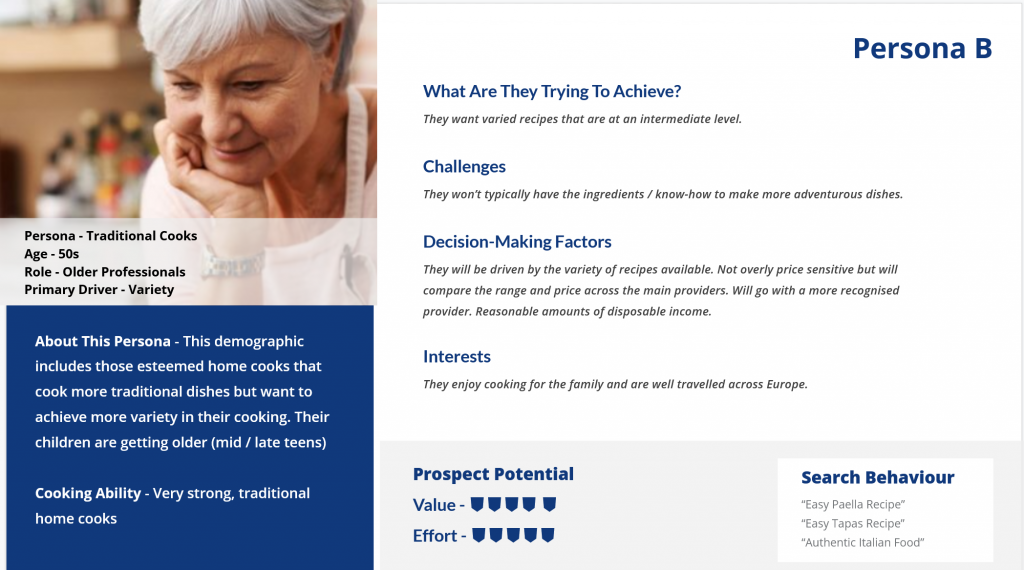
This demographic includes those esteemed home cooks that cook more traditional dishes such as cottage / shepherd’s pie, toad in the hole etc. However, they want to achieve more variety in what they can cook. This could be middle-aged parents, with teenage children, that have an interest in more varied food which is driven by international travel. As people have been deprived of travel during the lockdown period, this interest has only been heightened in order to provide them with the escapism that they crave.
“I want to learn how to cook more varied dishes, beyond my traditional home cooked meals”
Search Behaviour;
This audience will be looking for authentic and traditional recipes that they can recreate at home. Again, each of these have reasonable levels of monthly searches in the UK, such as the below;
- Easy Paella Recipe (3,600 searches per month)
- Easy Tapas Recipe (1,000)
- Authentic Italian Food (260)
- Chinese Food Made Easy (170)
- Easy Traditional Chinese Food Recipes (170)
- Authentic Indian Food (110)
Matching Content For This Persona (‘Authentic Italian Recipes’)
So, how do we create content to target the ‘Authentic Italian Recipes’ term? That’s easy, we just need to create a strong category page for that term, right? Wrong. It’s actually blog content that is ranking for this term, with the added complication of a local map pack to contend with, with the latter triggered by believing that the searcher is looking for authentic italian food near them.
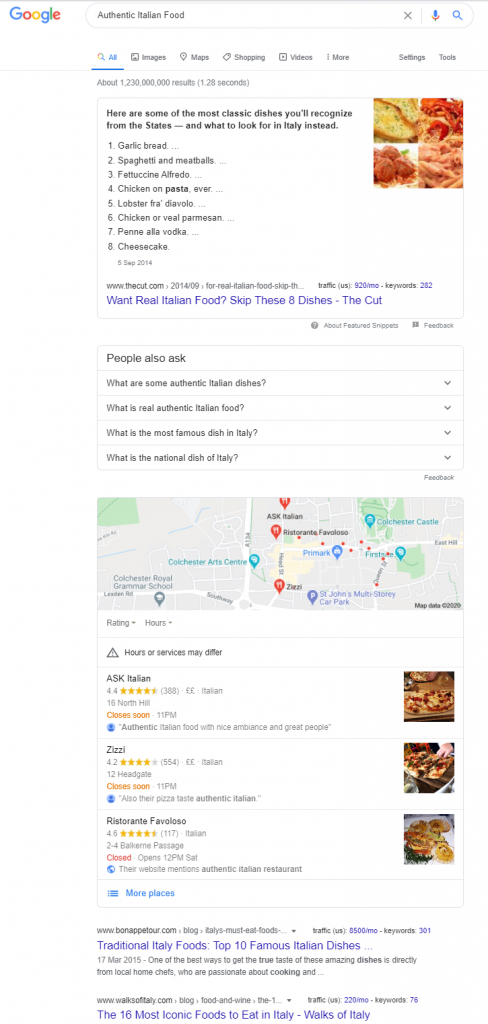
Furthermore, it’s worth paying close attention to the result that is currently occupying the featured snippet.
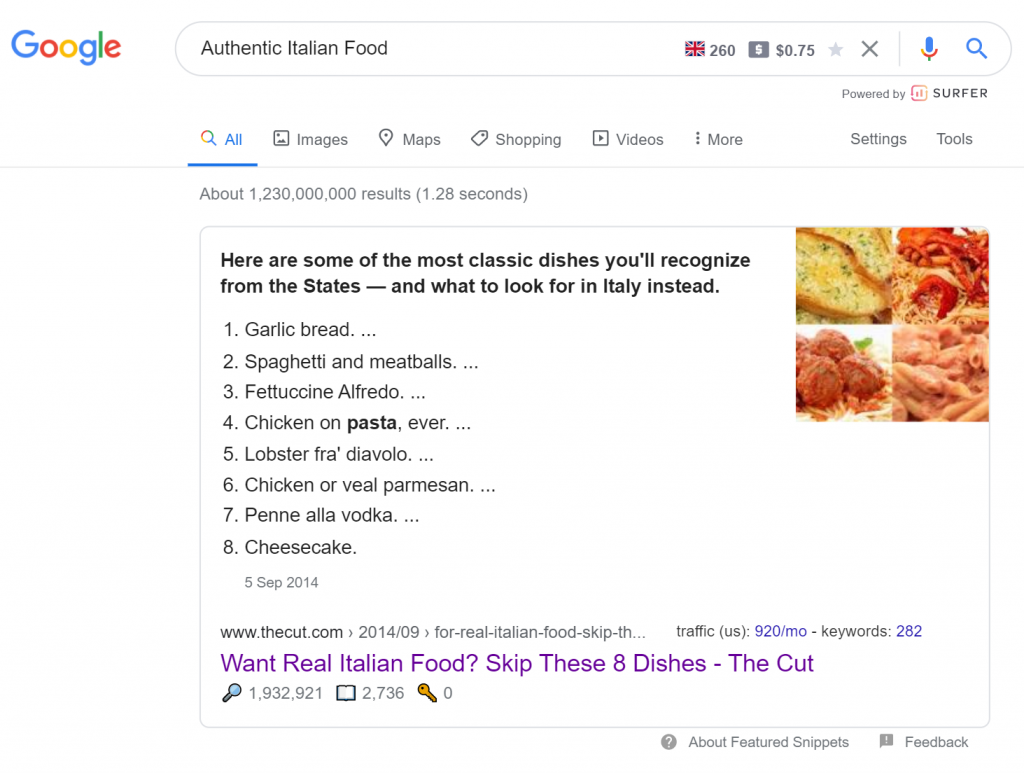
The result that is provided is along the lines of a myth-busting theme, whereby it’s telling you what authentic Italian food isn’t as opposed to pointing you in the direction of authentic recipes. When you couple this with the fact that the result is targeting a US audience and is over 6 years old, this makes this a good potential target if you add more value for this result.
Application
Use the search results as a guide, not a straight jacket, for your content creation. In the above example, you could be inclined to write a guide on how to spot inauthentic Italian recipes but, instead, you may think that a blog showing you how you can recreate authentic recipes at home or even video content may be a better result, so then create it.
The following piece of advice has stuck with me about intent, with it originating from Ice Hockey star Wayne Gretzky but having been liberally quoted across both marketing and business literature.
“Skate to where the puck’s going, not where it is now”
Wayne Gretzky
Afterall, we’re aspiring to create the best result for users and not just making a more homogenous web, so think what the best result is for users both now and into the future.
PPC Opportunities
Despite Gousto having two suitable landing pages for the ‘Easy Paella Recipes’ query, none of which currently appear in the top 100 results (potential keyword cannibalisation at play). Again, there isn’t any paid competition for this term so I would look to run an ad, similar to the below, as a test for this audience. Please note the use of the structured snippet extension to communicate the types of cuisine which helps to save valuable characters within the main ad itself.
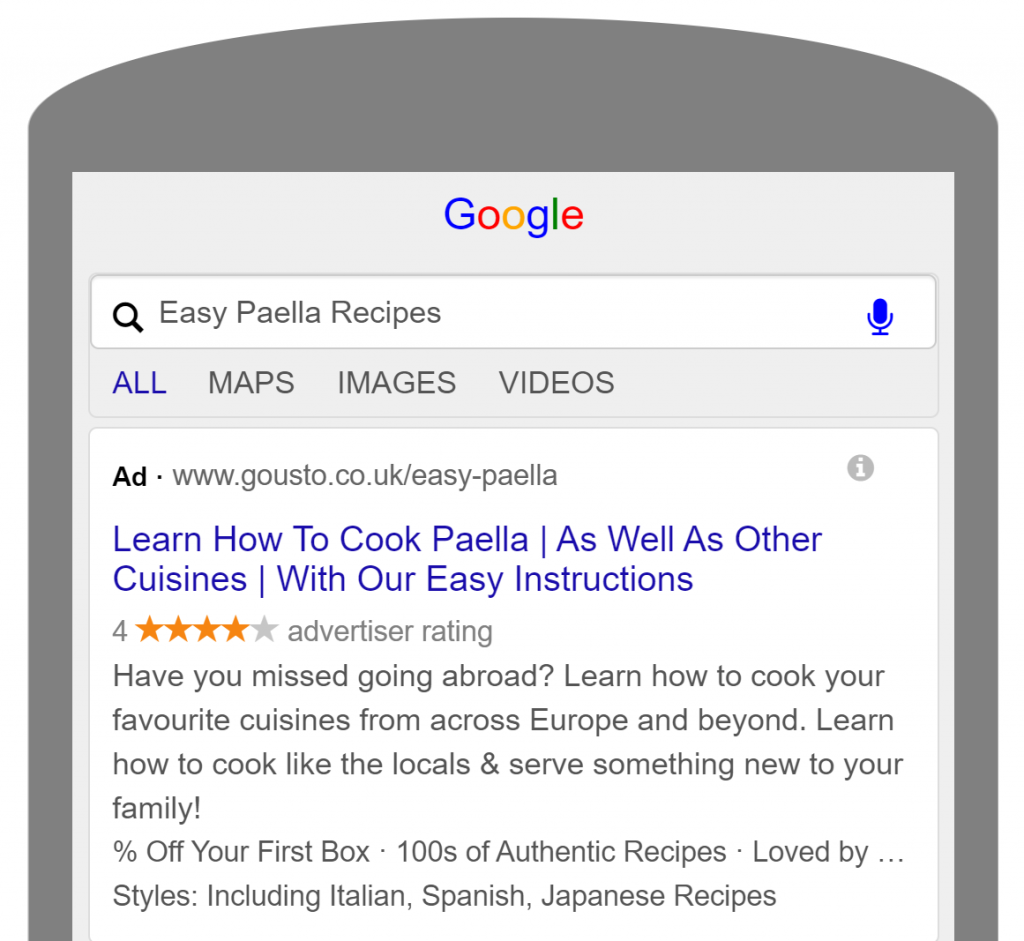
This ad also includes topical messaging that will resonate with the frequent traveller audience and also doesn’t overwhelm them by stating the help of the step by step instructions (without patronising the skilled cook audience).
Persona C – Novice cooks – wanting to learn to cook
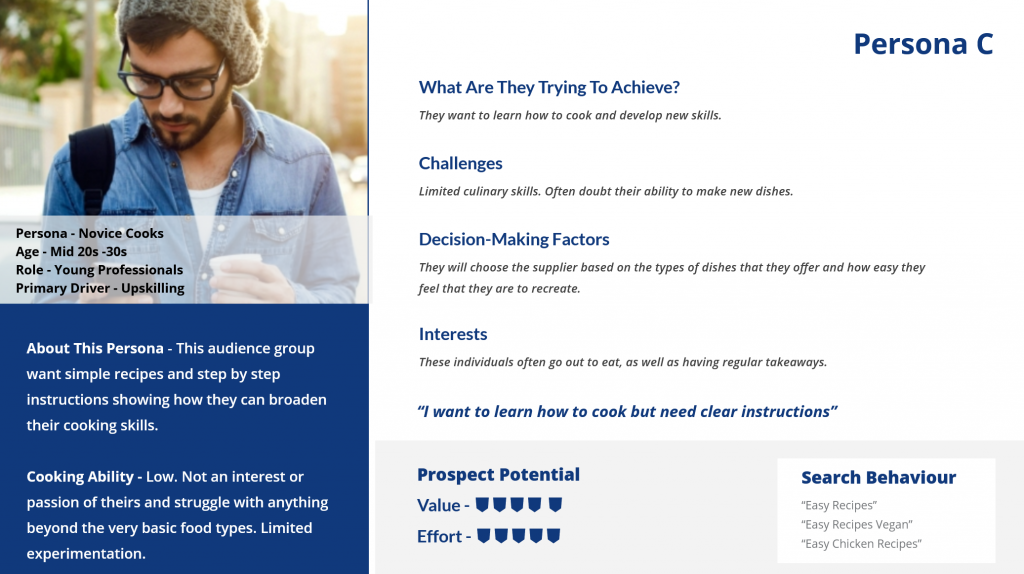
This audience group wants simple recipes and step by step instructions showing how they can broaden their cooking skills (very different to the skilled, yet safe, Persona B cooks). The number of people in this category has ballooned during lockdown, see below from Google Trends for ‘Easy Recipes’ (with a noticeable spike at the end of March / early April), with many seeing cooking as an enjoyable activity as opposed to a daily necessity (which has been further helped with the new found time-rich audiences). It’s likely that, post-lockdown, these habits and behaviours will persist and feature prominently in ‘the new normal’.

“I want to learn how to cook but need clear instructions”
Search Behaviour;
The types of searches that these individuals would perform include the following;
- Dinner Ideas (90,500)
- Dinner Recipes (90,500)
- Easy Recipes (18,100)
- Easy Recipes Vegan (12,100)
- Easy Chicken Recipes (9,900)
- Learn To Cook (1,300)
Matching Content For This Persona (‘Easy Recipes Vegan’)
Again, our first port of call is understanding what is being rewarded currently and reviewing the value provided by the page in question and how we can meet and exceed that value with our own content.
The best performing content in this space are category pages, showcasing a high breadth and variety in the recipes that they feature. Again, it’s BBC Good Food and the Jamie Oliver site that feature highly for the ‘Easy Vegan Recipes’ query. Therefore, if you want to try to rank alongside these examples, you need to create strong category pages offering similar recipe inspiration.
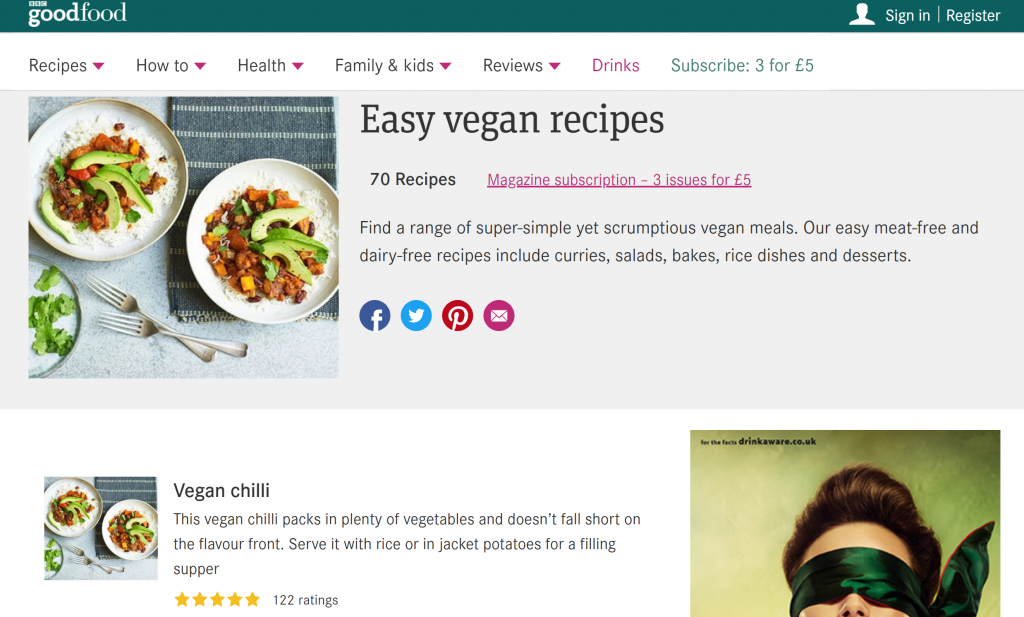

While taking on the likes of BBC Good Food and Jamie Oliver is particularly difficult for many brands, Gousto, Hello Fresh and Mindful Chef all have highly authoritative domains in their own right. While I personally dislike many Domain Authority metrics and prefer individual page metrics, they do all boast Domain ratings between 58 and 68 according to Ahrefs (see below).
| Brand | Domain Authority |
| Gousto | 66 |
| HelloFresh | 68 |
| Mindful Chef | 56 |
Therefore, if any of these were to create a competing category page that houses all the vegan recipes together and adhered to general best practice (accessibility, architecture, speed etc) they would be able to rank in this space.
Other Considerations
If you’re creating a category page with 50+ recipes, you may consider implementing an infinite scroll solution. However, remember the following from Google’s Martin Splitt;
“Googlebot cannot crawl content that loads only after a page is scrolled”
So, be sure to use the Rich Results Testing tool to see what Google can access (more on this later on).
PPC Opportunities
Another untapped area, from a paid perspective, is the SERP currently for the aforementioned ‘Easy Recipes’.
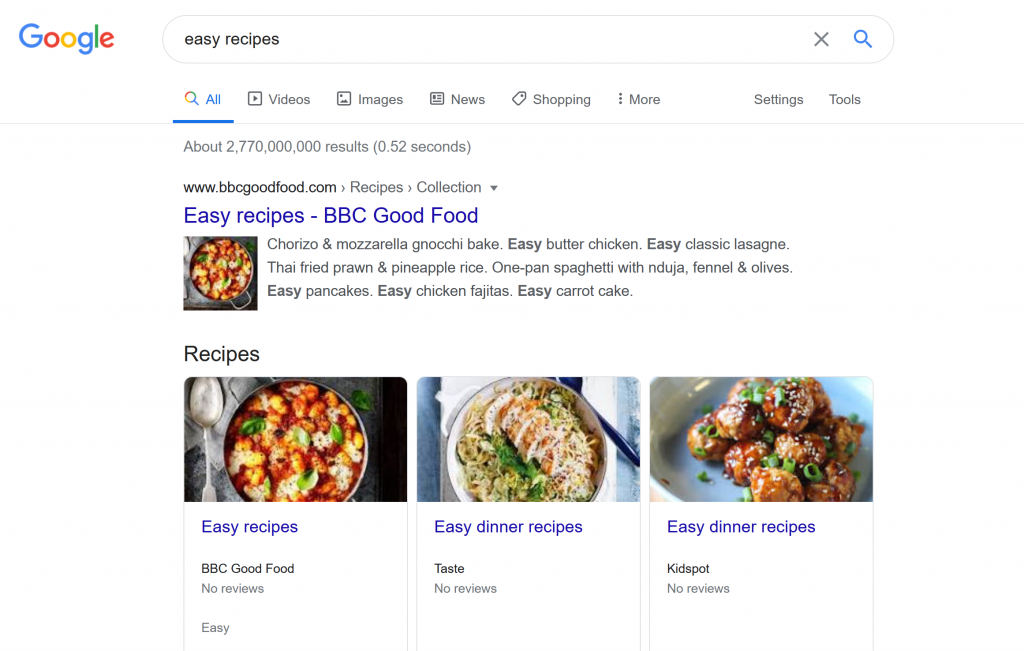
While these may have been individuals looking to ‘steal’ good recipes, with strong CTAs and a clear conversion rate optimisation focus could become regular subscribers. This could include reinforcing the discounts available for your first 3 boxes and other key sales messages on-page. You can also remarket to these individuals that are viewing the recipes, then leaving the site, by creating a separate audience within Google Analytics.
Another target could be ‘learn to cook’. At the moment, it’s currently a cooking certification that is bidding on this term but it would be possible to communicate the upskilling nature of these recipe boxes. In addition, creating a video tutorial would also be good from an organic perspective, as a video carousel is already currently displaying in the search results for this query.
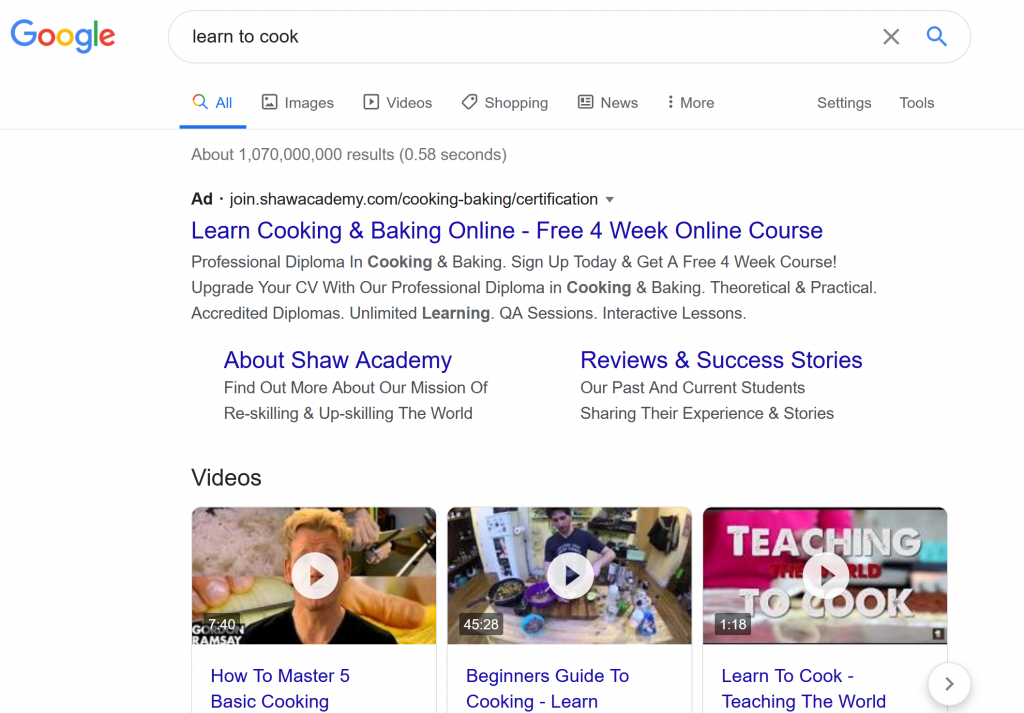
The below would warrant a separate ad group to target this term and communicates the trust signals with review stars, the breadth of recipes available, the fact you don’t need to shop for ingredients and encouraging them to make healthy meals, instead of relying on the novice cook’s staple; ready meals.

New Product Development
On the topic of ready meals, it’s interesting to see that Mindful Chef have recently launched their frozen meal ranges (screenshot from the Facebook ‘Ad Library’ within Mindful Chef’s Page Transparency section).

This will be targeted largely towards the novice cooks persona but also Persona A’s (driven by convenience and who may not want to cook every night) as well as the ‘yet-to-mention’ Persona E’s.
Application
In extremely competitive markets, such as the recipe box sector, further growth will typically come from four different areas, namely; Market Development, Diversification, Market Penetration and Product Development according to the highly referenced Ansoff Growth Matrix (shown below).
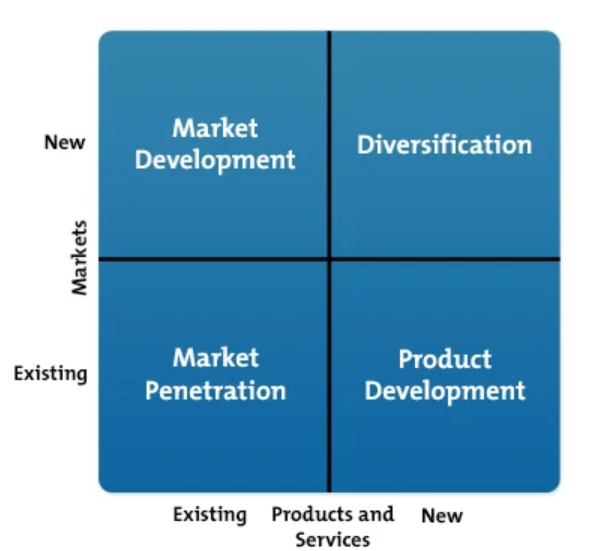
The four different strategies can be summarised as follows;
- Market Penetration – selling more within the current market (in many instances this involves taking market share from your competitors),
- Product Development – introducing new products in the same market, that appeals to new customers (such as the new frozen meal range above),
- Market Development – selling existing products to new markets,
- Diversification – by far the highest risk growth strategy is selling new products to new markets.
If the market you operate in is reaching saturation, it’s worth considering where additional growth (in usual business circumstances) is going to come from. This may take the form of a more aggressive pursuit of your existing market or a high risk, high (potential) reward diversification strategy, with countless success and failure stories across each strategy.
Persona D – Restaurant Goers – High quality meals at home
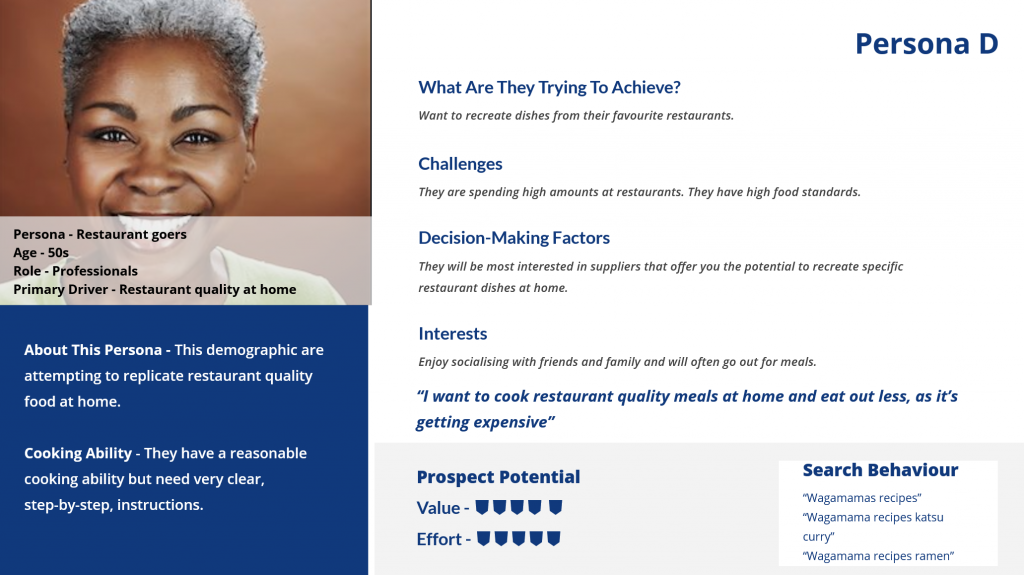
This demographic are attempting to replicate restaurant quality food at home.
Excluding the recent, highly popular ‘Eat Out To Help Out’ Government initiative, a meal out for a family of 4 can easily cost in the region of £80-£100 (if not more). However, when you can create three high quality meals at home for a family of four, for £46 per week, you can make a case for these subscription boxes being extremely cost effective (with the below example from Hello Fresh – note the emphasis on price per serving rather than total cost).

“I want to cook restaurant quality meals at home and eat out less, as it’s getting expensive”
Search Behaviour;
The scale of these monthly searches, from individuals looking to recreate restaurant quality food, is evidenced by the popularity of Wagamama searches.
- Wagamamas Recipes (8,100 searches per month)
- Wagamama Recipes Katsu Curry (8,100)
- Wagamama Recipes Ramen (1,900)
- Wagamama Recipes Chicken Katsu Curry (1,900)
- Wagamama Recipes Chicken Ramen (1,000)
- Wagamama Recipes Pad Thai (480)
- Wagamama Recipes Yaki Udon (480)
- Wagamama Recipes Chilli Squid (260)
There has been a noticeable increase, during lockdown, in the number of searches for the recipes from these leading restaurant chains with a number of publications revealing how to make your own at home, such as this Mcdonalds example (see the Google Trends data below).
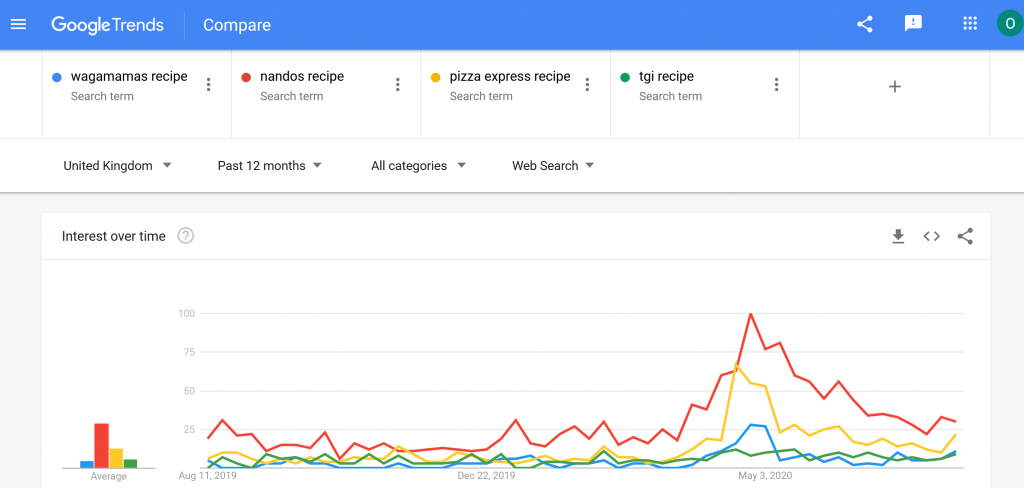
Matching Content For This Persona
With the news that Gousto has partnered up with Wagamamas this seems like a huge content marketing opportunity.
Currently, on the Gousto site, there are 3 pages which make a reference to Wagamamas in the page title, as shown below (although there are several more pages that mention Wagamamas on-page).
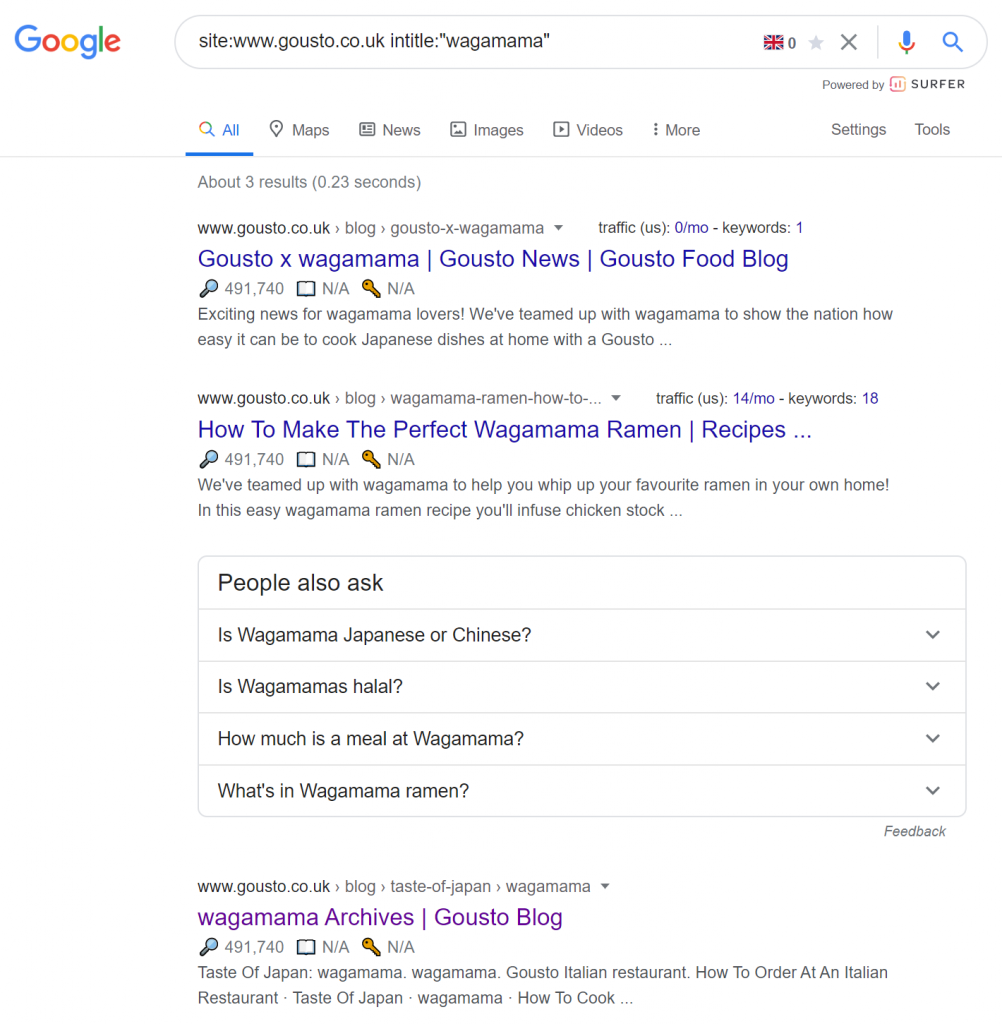
While the ‘Wagamama Archives’ page is likely to be a legacy (and automated) taxonomy page (shown below), I think that creating a standalone landing page would be a good addition to the site.
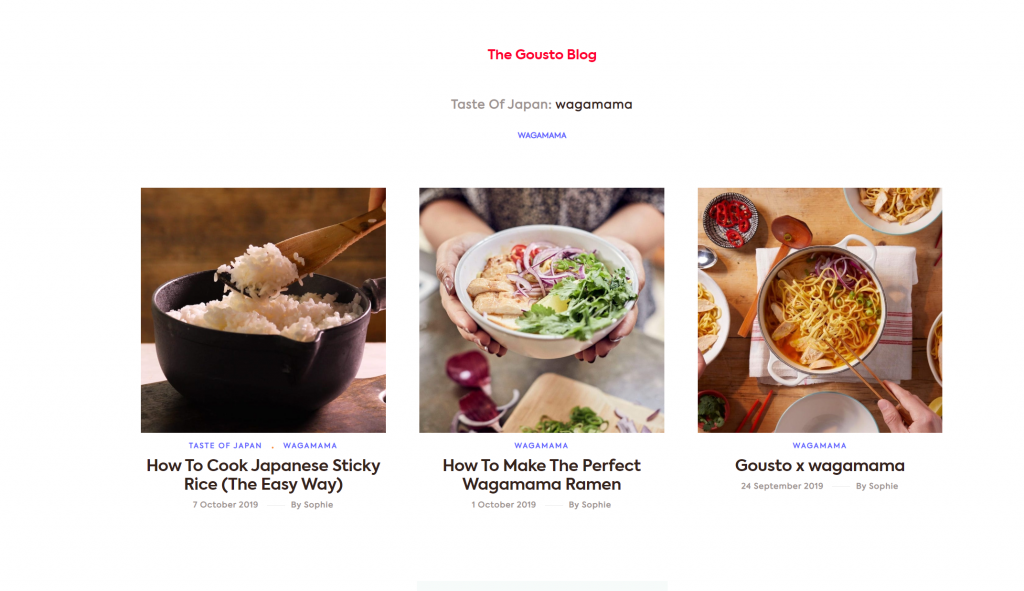
This would curate the Wagamamas recipes into one page on the site and should be prominently linked to sitewide. It should also take inspiration from the Wagamamas ‘giving you the recipe’ page. While this page (and the recipe cards in the SERP) are going to account for the majority of the clicks, this Gousto page would have the opportunity to capture some of the traffic. Especially when you see that the Recipes page for Wagamama is only available in the US and will redirect you to the UK Homepage (via the HTTP version of the page), as opposed to an equivalent page on the UK site (see below).
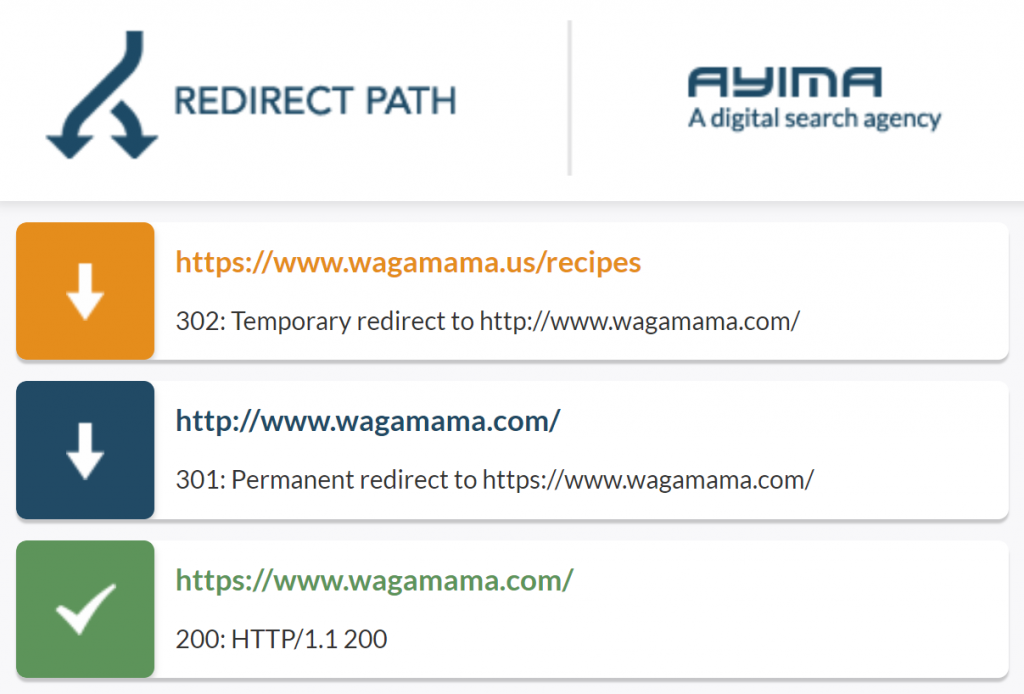
Therefore, frustrated users may head back to the SERP (where Gousto currently has visibility).
However, the content that is ranking is a blog and, while this is a comprehensive result that gives the user the information they need to replicate the dish, a standalone page that combines their entire Wagamama recipe range, would be a better result.
Application
Even if a page is currently ranking, think about what the best result is long-term and consider the intent of the searcher. Someone looking for ‘Wagamamas Recipes’ is looking for variety and a selection, as opposed to advice about how to recreate a specific dish.
The above blog post also only has Webpage mark up, as opposed to recipe mark up, which you can see here (although this will soon expire when the Structured Data Testing Tool is no longer supported). Conversely, the Gousto Cookbook page, which has an associated recipe card, does have the correct mark up in place, as does the Good To Know recipe in the SERP which will help with the click-through rate and make the result more appealing to click, with the addition of the review stars and image.
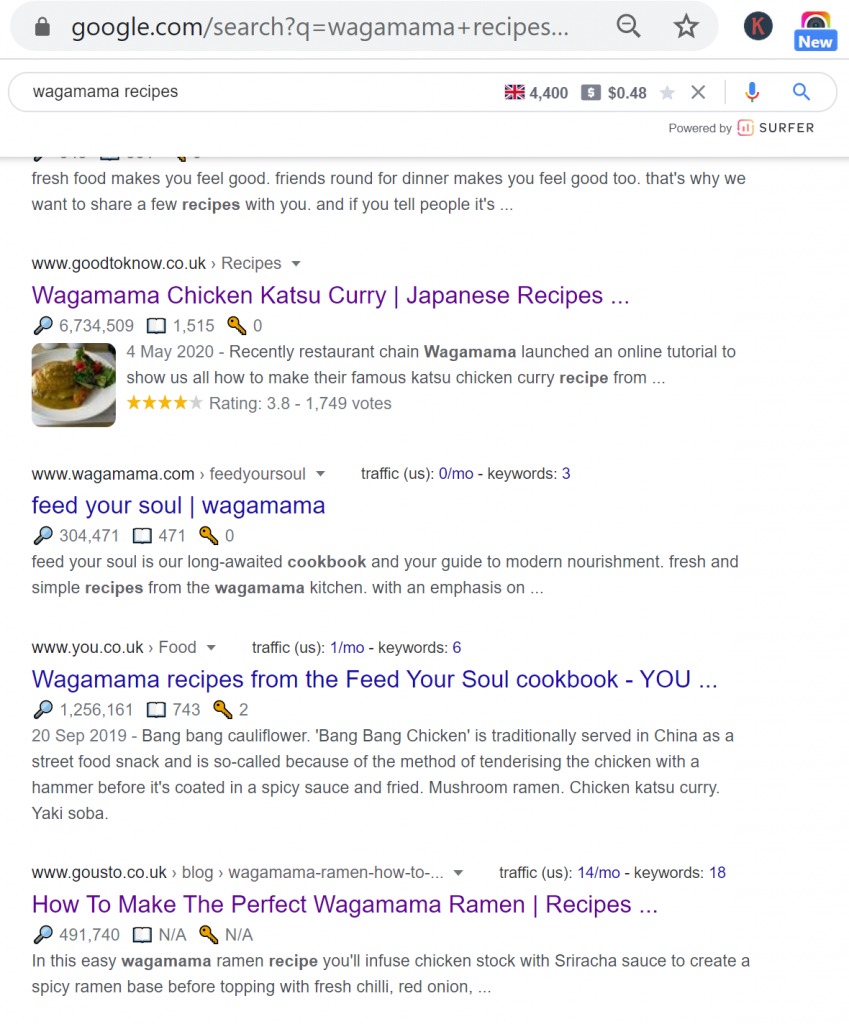
PPC Opportunities
This ad mock up is tailored for this specific query and also plays on the consumer motivation of social acceptance and respect by impressing friends with high quality meals. Similarly, mentioning the number of people that use this service helps to communicate trust, along with the review stars, and is a key component of ‘social proof’.
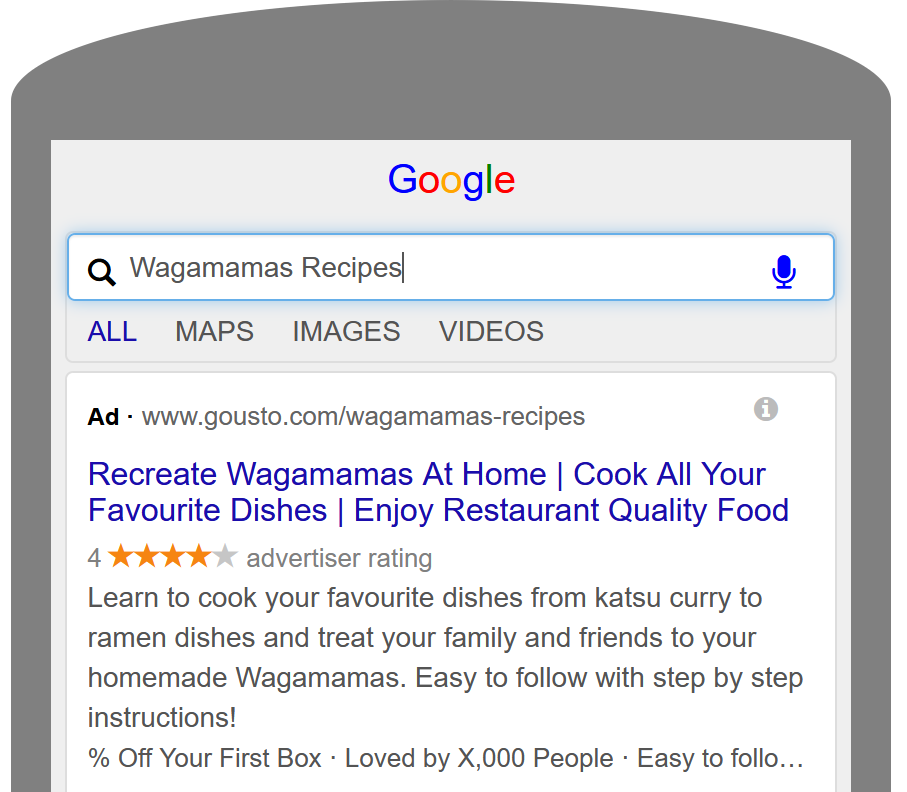
Persona E – Looking For Recipes for Dieting / Weight Loss

This audience are looking for recipe inspiration that is driven by their desire to lose weight.
“I want to cook healthy meals as part of my weight loss plan”
Search Behaviour;
Some of the terms, in this space, have particularly high monthly search volumes and are associated with leading weight loss brands such as; Slimming World and Weight Watchers. Some of the most interesting queries include;
- Slimming World Recipes (135,000 monthly searches)
- Weight Watchers Recipes (12,100)
- Recipes Keto Diet (12,100)
- Recipes of Weight Loss (2,400)
- 5 2 Diet Recipes (2,400)
- Diet Recipes Low Carb (1,600)
- Recipes for Slimming (880)
- Recipes for Weight Loss (500)
Content Opportunities;
For a brand whose main point of difference is centred around low carb recipes, Mindful Chef should be visible for the term ‘Diet Recipes Low Carb’. However, they don’t currently occupy a position within the top 100 results.
Again, it’s BBC Good Food that offer the best example landing page, with this category page being a good basis for Mindful Chef.
PPC Opportunities;
An example ad for the term ‘5 2 diet recipes’, which should mention these extreme diets on the landing page, would be as follows;

However, the copy used in the existing ad (which is currently displaying for the branded search of ‘Mindful Chef Low Carb’ to avoid traffic going to the ‘app’ subdomain) would be suitable for the above query (depending on its current performance / engagement).
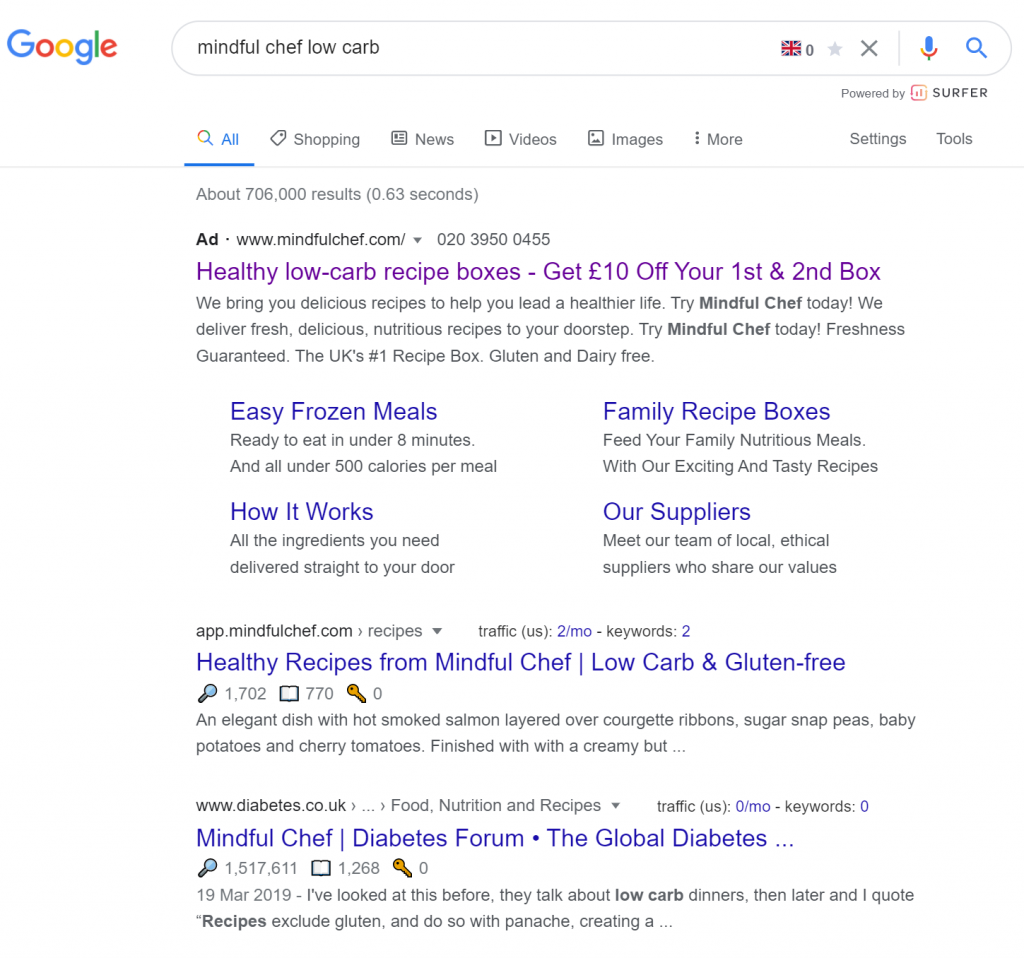
4. Understanding Your Keyword Priorities & Where Prospects Are In The Buyer Cycle
So, now that we have an understanding and awareness of how users (across different persona groups) are searching, it’s imperative that you consider where they are in the buyer journey and how closely they relate to the product / service you’re offering (and, therefore, the likelihood of them converting).
If we take things back to basics, you could group them as Primary, Secondary and Tertiary targets.
Example Keyword Targets
Primary Terms:
Typically, these are the ‘fat head’, highly searched terms / topics that relate directly to the product / service you provide and are your revenue-making terms. The users searching for these already understand the need for your product / service and, therefore, are looking for the best provider against their own conscious (or subconscious) criteria.
These are typically ‘bottom of the funnel’ / close to conversion terms and could include the following in the Recipe Box Sector.
- Food Subscription Boxes,
- Recipe Boxes,
- [Your Brand] Recipe Box
- Food Delivery Boxes
- Low Carb Recipe Boxes (particularly important for Mindful Chef)
Secondary Terms; (Upsell after giving them the recipe)
While not your immediate focus, they offer great potential for your business and have a reasonable search volume. These are closely related to your business but users aren’t looking for your exact solution and could include the following;
- Mexican Recipes
- Indian Recipes
- Italian Recipes
These are users looking for home inspiration but, as we alluded to earlier in the ‘Easy Recipes’ example, could become customers with an effective landing page experience, persuasive and compelling copy and powerful remarketing.
Tertiary Terms;
These are typically question queries that support your primary terms and offer long-tail content opportunities.
- Quick Dinner Ideas
- What to Cook for Dinner?
- Hello Fresh vs Gousto

Users will typically do even greater levels of due diligence ahead of entering into a subscription, due to the on-going commitment, which means that you should be framing content for these users in the ‘consideration’ stage. As you can see from the below screenshot, the comparison query of ‘HelloFresh vs Gousto’ has reasonable search volume (and no paid competition currently).
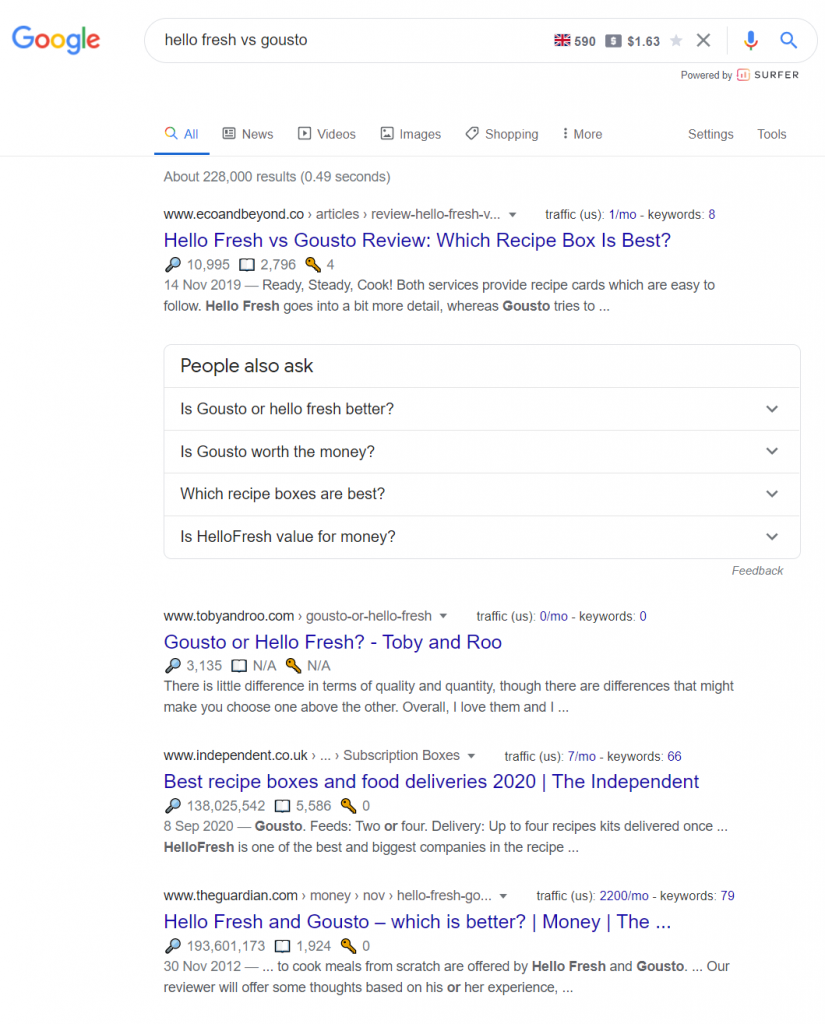
While it’s notoriously difficult to target these queries, as users are effectively looking for an impartial appraisal of each, it isn’t an impossible target. As Ross Simmonds references in his fantastic blog looking at the content marketing machine that is Canva, comparative search does offer a wealth of opportunities. Mindful Chef did have a comparison table, showing the benefits of their recipe box relative to the leading competitors, that they featured on their Homepage previously but it should be housed on a standalone page targeting this topic.
This more direct comparison offers huge potential, especially when the current marketplace reaches saturation, the next opportunity for growth will mainly come from ‘eating someone else’s lunch’ (or ‘market penetration’ as I mentioned earlier) and taking market share from your competitors. The below shows the comparisons that people are searching for, with ‘Gousto vs HelloFresh’ having a monthly search volume of approximately 880 (according to Keyword Keg).
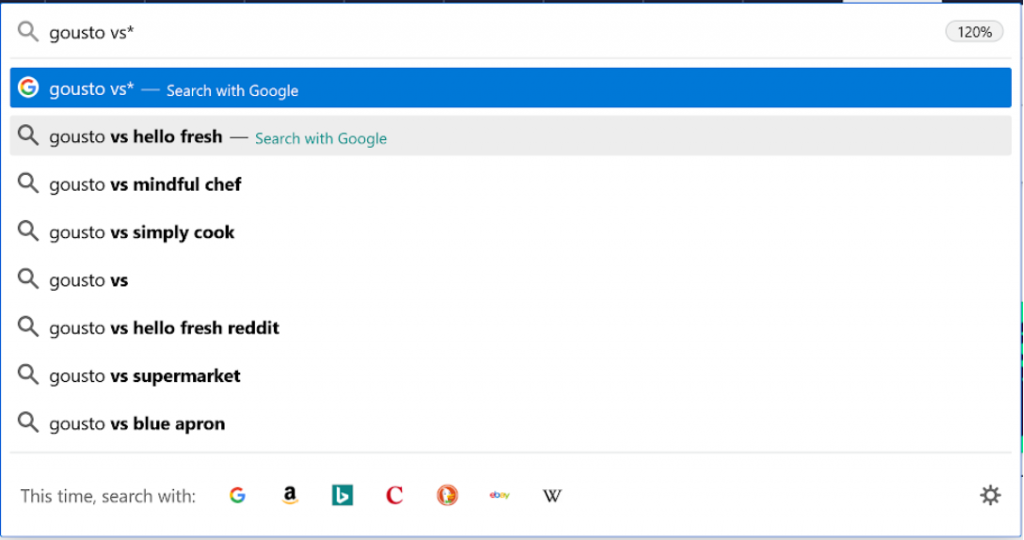
Application
Ask yourself, are you capturing all of the traffic around your brand (including comparative search)? It’s not always a given that you’ll receive this traffic, even though users are actively asking questions around your brand, if other providers are answering these questions more effectively than you. Make sure you succinctly answer these questions, so it’s coming from you rather than a third party, with Mangools, SEMrush’s Keyword Magic Tool and, Hannah Rampton’s PAA extractor tool, all a fantastic means of getting this data.
A further review of the People Also Asks shows some of the reservations that users have prior to joining subscription companies. Most notably, about the ease of cancellation and whether introductory offers are as good as they sound. These are all potential barriers to conversion so your prospective customers should be reassured within your landing page copy, as well as having trust signals strategically placed sitewide.
While HelloFresh does successfully capture this traffic, it’s their New Zealand and US domains that are appearing. This information should be readily available for each country variation.
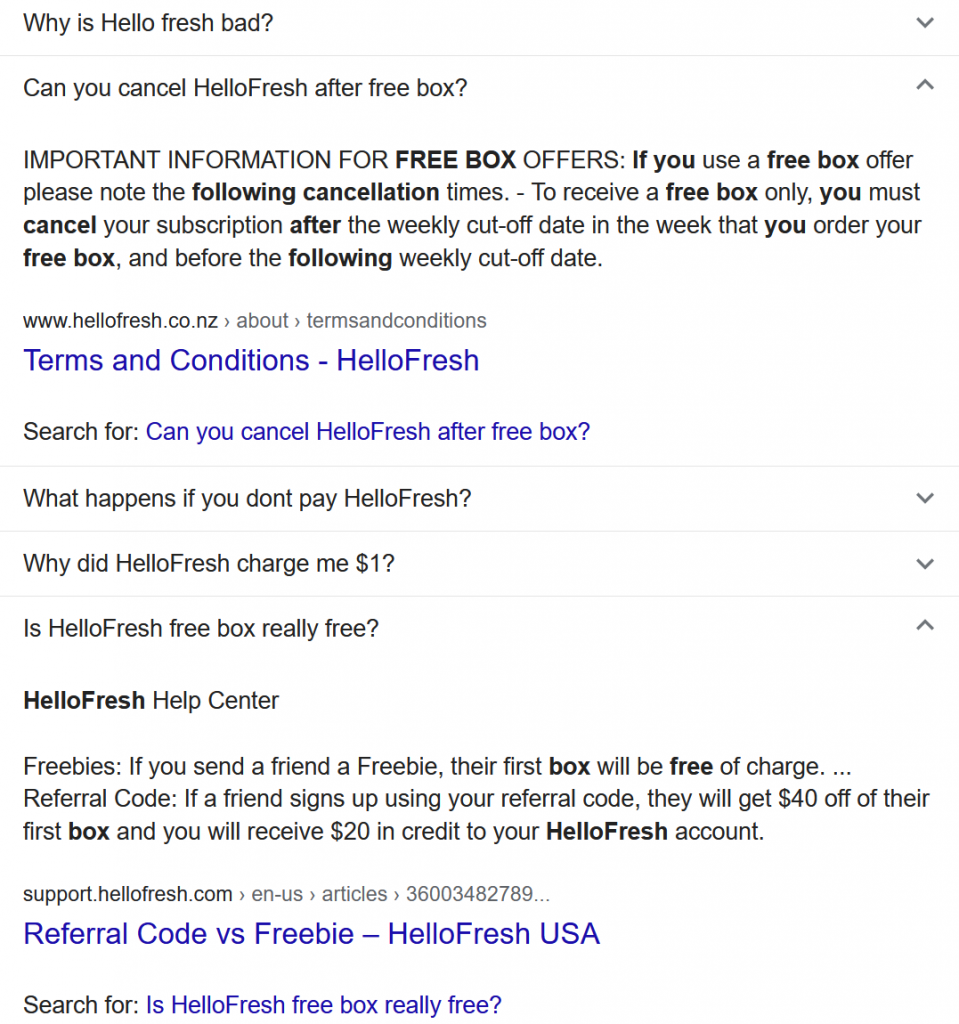
5. Who are they targeting currently?
So, now that we know where the opportunities are across their different key personas and have an understanding of where the prospects are in the buyer cycle, it’s worth reviewing where the three market leaders are focusing their efforts currently.
While the size of the team and resources does need to be factored in, it’s interesting to see the difference between their current content priorities.
Existing Visibility
With a number of the main players in this space using subdomains, looking at the visibility of the root domains (e.g. gousto.co.uk) offers the best opportunity for comparison. The below highlights that Mindful Chef have less visibility than the bigger players of Gousto and HelloFresh currently but with, arguably, a stronger brand positioning around their low carb meals.
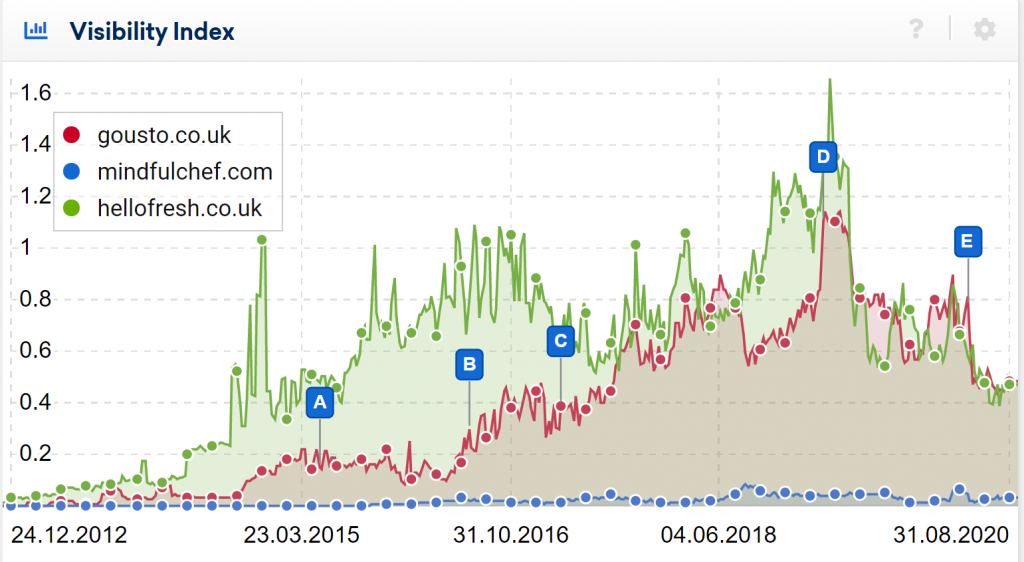
Mindful Chef;
According to Ahrefs, Mindful Chef (including subdomains and excluding branded queries) have 194 terms in the top 10 results. Most of their visibility, for high volume keywords, is centred around primary queries such as Recipe Boxes (position 6), Recipe Boxes UK (position 4) and Food Boxes UK (position 6).
However, they have also got impressive rankings for terms such as;
- Nandos Butterfly Chicken (position 1 approx. 800 searches per month)
- Vegan Food Boxes (position 2 – approx. 300 searches)
- Vegan Recipe Box (position 1 – approx. 200 searches)
Their dominance of the Vegan Recipe Boxes SERP is particularly impressive, with Gousto currently on pages 2 / 3 for this term and Hello Fresh beneath them on page 1.
Upon closer inspection, their dominance over Hello Fresh and Gousto, for this term, is fully justified. Mindful Chef have an extremely strong landing page (shown below), which includes testimonials, recipe examples and clear CTAs.

Conversely, it’s the HelloFresh vegetarian recipe box that ranks for them (as well as the Australia page counterpart – which could be a sign of international targeting issues). Similarly, it’s the Gousto Homepage that ranks for this term.
For me, there’s a huge opportunity for Gousto to create a targeted landing page for ‘Vegan Recipe Boxes’ and link to it as an upsell CTA on each of their individual vegan recipes. Currently, the ‘Try Gousto Now’ CTA goes to the Homepage, with all of the PageRank then passed to the Homepage as opposed to a more relevant landing page.

The fact that there are high levels of paid competition on this primary term suggests that it converts well, as well as an attempt to capture more of this booming vegan market. One way in which Gousto could improve their results for this particular term, from their paid activity, would be to utilise a highly relevant PPC landing page or to use the new page mentioned above. At the moment, they feature meat based dishes on their PPC landing page for ‘Vegan Recipe Boxes’ (see below).
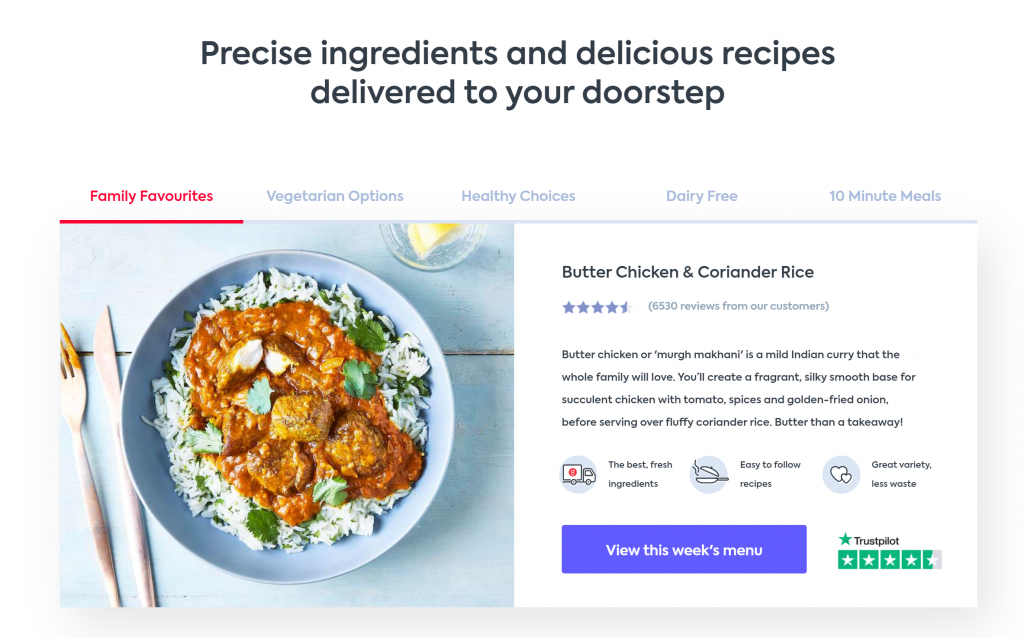
Mindful Chef’s rankings for ‘Recipe Box’ related terms is thanks to a very deliberate attempt to create targeted landing pages, which are prominently linked from the main navigation.
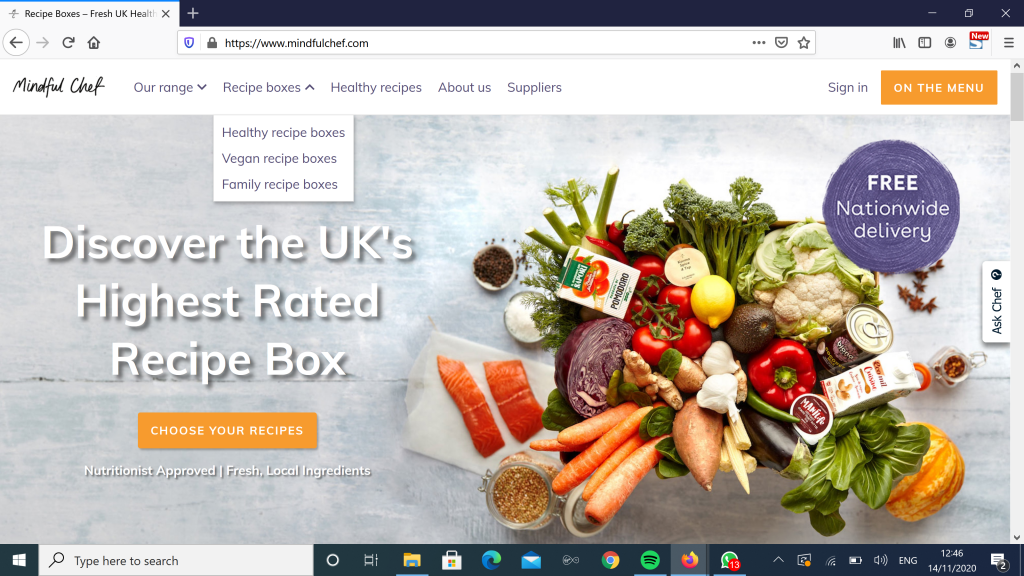
To further support these specific landing pages, I would look to link to these pages from the main Homepage body as it’s likely to be of interest to users and is also a good way of distributing the authority that exists with the Homepage.
Gousto
Gousto’s visibility is far higher than Mindful Chef’s, with Ahrefs reporting that they have over 3,000 queries in the top 10 results (excluding branded queries and including all subdomains).
While they do boast strong rankings for primary terms, much of their visibility is for popular recipe searches (secondary terms) including ‘Mediterranean Recipes’. As you can see from a quick content gap analysis comparing them to Mindful Chef and Hello Fresh, the other leading recipe companies don’t actively target these types of terms.
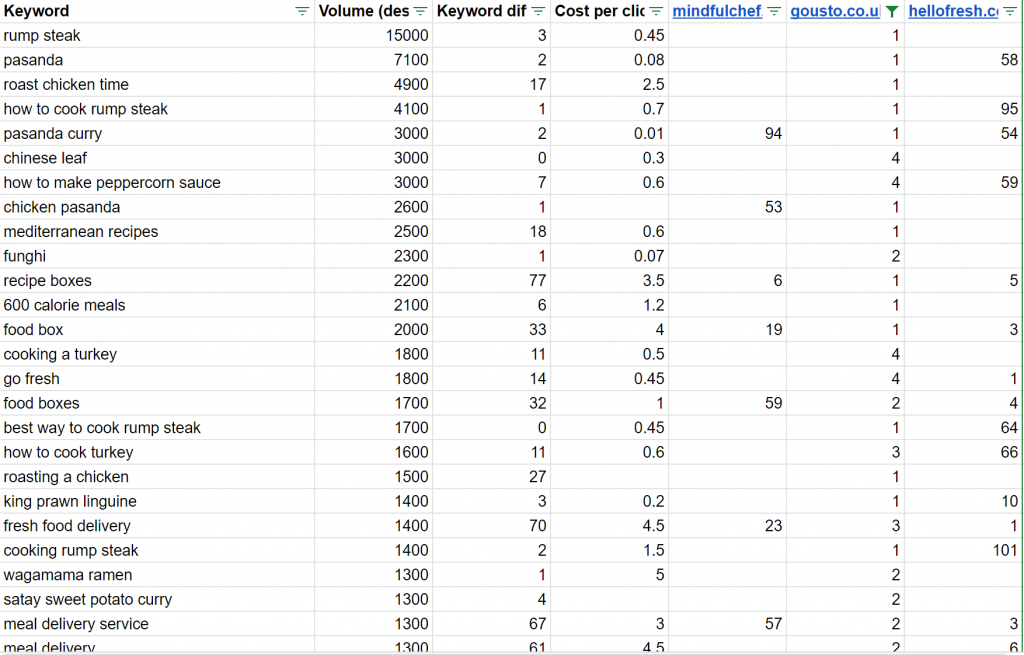
One term that stands out, from the above content gap analysis, is the query ‘600 calorie meals’. Currently, it’s only Gousto that have visibility for this term but this ties in with the brand positioning of Mindful Chef, who could target this page more aggressively, from both a paid and organic perspective.
The performance of Gousto’s Cookbook section, and therefore similar secondary targets (e.g. Prawn Recipes) could be greatly improved with more effective internal linking. Not only is the only link to the ‘Cookbook’ from the footer but there are further complications for search engines.
Currently, Ahrefs is reporting that there are no internal links to the Prawn Recipes page on the site (this can be further explored by using your crawling software e.g. Screaming Frog, Sitebulb or DeepCrawl).
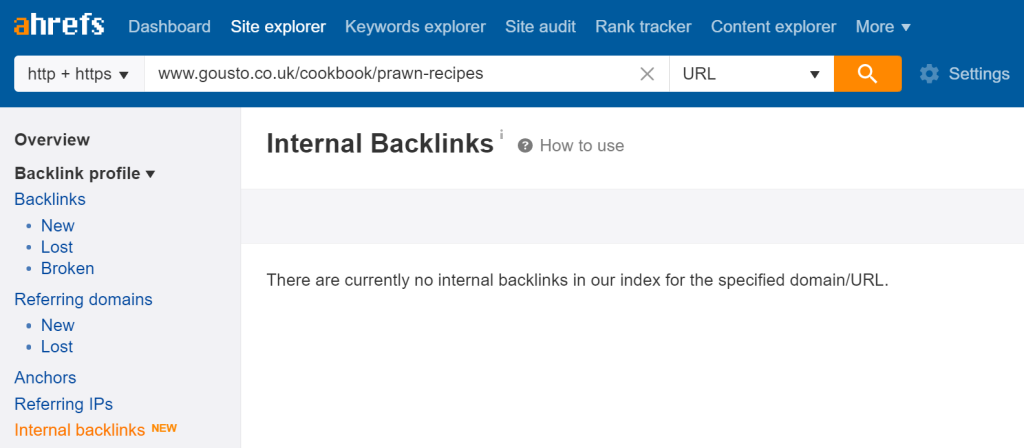
Again, looking at this more closely, we’re able to see that Googlebot can’t extract these URLs from the rendered HTML. Instead, they only appear after the user interacts with the page (see below).
You can test your implementation by checking the rendered HTML in the Rich Results test. This Jamie Oliver example highlights that Google has access to the recipes that are initially hidden on the page, as opposed to displaying only when there is user interaction on the page (in the Gousto example above).
HelloFresh
Similarly to Gousto, HelloFresh have first page visibility for a high number of terms according to Ahrefs (over 2,500 terms). These are nicely dispersed across each buyer stage with high levels of visibility for the following terms;
Primary;
- Meal Delivery Service
- Fresh Food Delivery
- Meal Prep Delivery
Secondary;
- Turkey Steak Recipes
- Creme fraiche pasta
- Roast aubergine
Tertiary;
- How to cook gammon steaks
- How to cook celeriac
One other standout term is ‘Food Subscription Box’. Using Sistrix’s historic rank and SERP comparison tool, we’re able to see HelloFresh’s progress for that term over the last month.

Looking at the SERP, there is an element of fractured intent in operation, with a mixture of transactional intent (with the Shopping Ads), informational intent for those at the consideration stage with Which? and The Standard comparing the different providers, an aggregator site collating all of the varying subscription offerings, as well as Gousto and HelloFresh offering the solution.

It’s Gousto’s ‘Best Subscription Box’ page that is ranking for this query but, interestingly, it doesn’t have first page visibility for ‘Best Food Subscription Box’ as the comparison sites are a much better result for that intent.
Application
There’s no replacement for understanding intent. If you’ve seen high levels of search volume and want to capture some of that traffic, you have to fulfil the intent of the searcher and provide the best result for their needs. In the above example, the best result is a review of each of the providers and, therefore, you’re highly unlikely to rank for that term by talking about why your subscription box is the best.
Other Observations
Subdomain vs Subfolder
Both HelloFresh and Mindful Chef haved housed their content on separate ‘blog’ subdomains. While it’s been a topic of contention for many years in the SEO industry, I would advocate having the blog posts in a subfolder rather than on a subdomain.
Mindful Chef have since made the (right) move to include their blog content on the main domain (see the content available on the blog subdomain as recently as June 2020 using The Wayback Machine) but navigating to the key content such as Recipe Boxes, is very challenging for both users and search engines alike and, therefore, the internal linking strategy could be significantly improved (shown below).
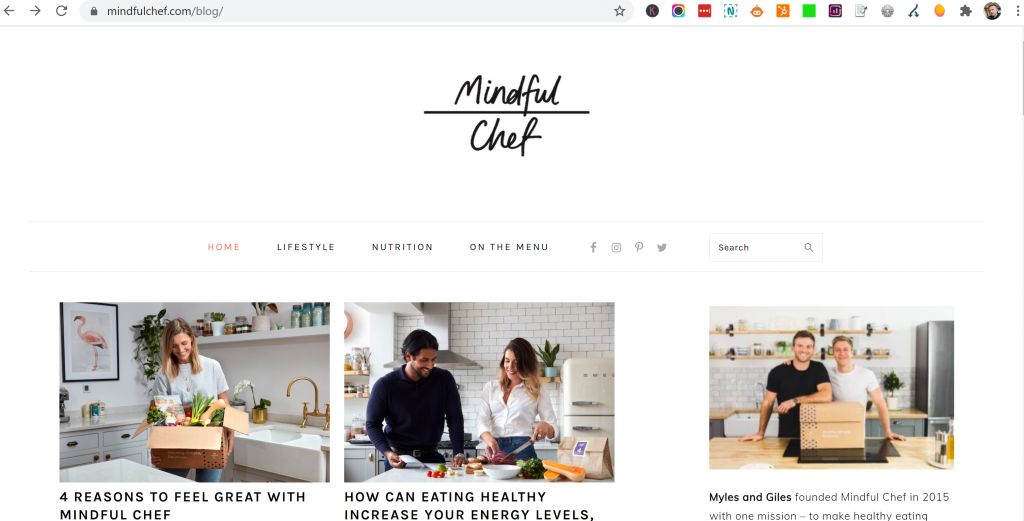
While the blog is on the main Gousto site, it is a similar challenge to navigate to the key information with the absence of the normal navigation on that section of the site.

Interestingly, just six of HelloFresh’s top 50 best performing pages, in terms of traffic, (according to Ahrefs) relate to content on the ‘blog’ subdomain. However, unlike their two main competitors, it’s easy to navigate to the main site from their blog content.
6. Maximising Your Content Marketing Efforts
To reiterate a point that I’ve mentioned throughout, improving your visibility around target topics and acquiring traffic to your website is just the first step. Utilising paid channels to first test your keyword targets is a very worthwhile exercise. This way, you know that improving your visibility for these terms, from an organic perspective, will have a positive business impact, before you invest time and resources to do this with very little return.
Similarly, remarketing to the users that are visiting your website (especially for recipe inspiration) is essential so that they can form part of a wider nurture campaign. This also extends to making CRO improvements, over time, to make the process from landing on the site to conversion as painless as possible.
The site architecture, internal linking and general internal promotion of content should be carefully considered, as well as re-submitting updated content within Google Search Console to speed up the time in which it’s fetched by Google.
7. Are these food subscription companies here to stay?
With the aforementioned growth in sales and new found consumer habits during lockdown, this industry looks set to go from strength to strength.
However, with any booming sector, there will be indirect competitors looking to capture ‘a slice of the pie’. We’ve already seen Morrisons, M&S and Aldi release their own recipe boxes and it’s not beyond the realms of possibility that some restaurant chains, such as Wagamama, could move into this space (as long as it doesn’t affect restaurant visitor numbers). Not only will this make the space more price competitive, this only accentuates the need to establish your brand positioning relative to the competitors, communicate your own point of difference and sufficiently differentiate yourself, so that it doesn’t become a ‘race to the bottom’.
The industry is already awash with a number of challenger brands and more bespoke solutions (e.g. All Plants offering purely vegan recipe boxes). With this increase in choice, the bargaining power of buyers has greatly increased. However, with the nature of the subscription model, buyers do tend to be extremely loyal to these types of providers, despite the relative ease of cancellation if they decided to do so. This service also plays to the time-poor nature of working families and the treating angle of consumer behaviour, which only points to further growth for these organisations.
However, the number of new customers will soon plateau if these organisations remain too focussed on only individuals actively looking for this specific service. They need to extend their thinking and consider ways, such as those that I’ve suggested, of how they can create new demand, rather than just satisfying existing interest. But they can only truly achieve this once they’ve got a detailed understanding of their different audiences and their drivers and motivations.
Recipe Box brands may begin to re-evaluate the role of content marketing and could even gravitate towards these informational sites and place a greater emphasis on upselling to these individuals. There is also a chance that these informational sites could move forward in the supply chain and start offering their own recipe boxes. Alternatively, this could lead to mergers and acquisitions with these high quality content publishers, who would in all likelihood possess large customer databases and a plethora of opportunities with these foodies.
Regardless of what is in store for this sector in the coming weeks, months and years, content marketing will undoubtedly play a key role in the next step of their business lifecycles. The brand’s that embrace it to the fullest will reap the rewards, as long as it is underpinned by a fantastic service and ever-evolving product offering, as well as a clear and valuable brand positioning. Only when you’ve got these in place, alongside clearly defined brand personas and an understanding of their motivations and drivers, will you begin to unlock the true power content marketing has to offer.